#as a theme. and not a particularly positive depiction either.
Text


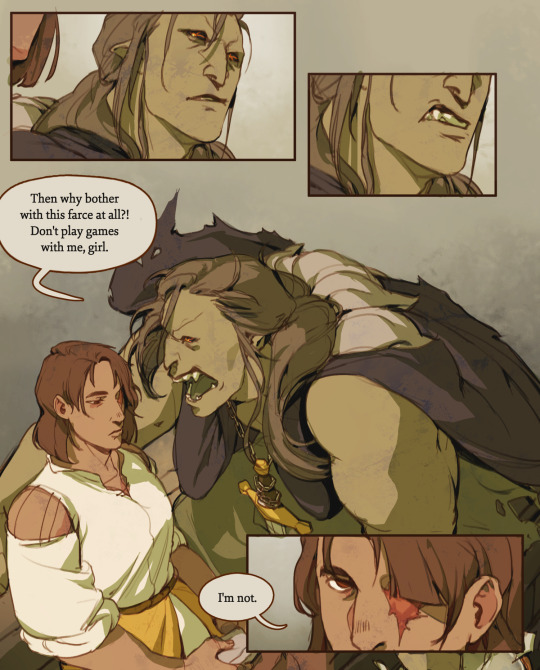

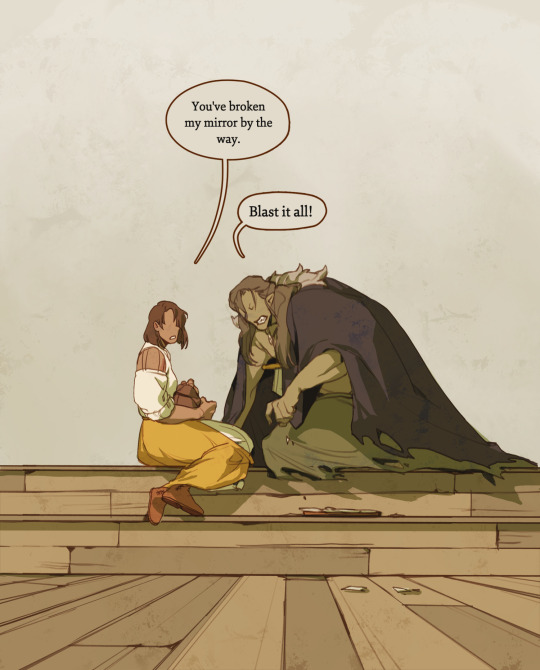
seeing clearer
(sequel to another comic of mine, the calamity.)
--
all my other comics
store
#cw: eye scarring#cw: christianity#as a theme. and not a particularly positive depiction either.#the calamity has anger issues but is earnestly trying her best#the survivor is patient#and also not scared of her at all#the calamity is talking about the story of samson and delilah in pg 2 btw#i tend to only make oneshot short story these days but im fond of this pair#had the urge to draw something a little mundane with these two and the slowest slow burn of a relationship you could ever imagine#also usually a broken mirror would equal 7 years of bad luck but the calamity so outclasses it as far as bad omens go#im pretty sure the effects are just cancelled out#anyway#next comic will be a different story entirely i promise#thank you for your patience#and as always#thank you for reading#comic art#sapphic art#stillindigo art#hearteaters#stillindigo comics
2K notes
·
View notes
Text
I am not playing the “you're racist if you say Ed is abusive" game with y’all 😒
This shit is not new or helpful to POC in the fandom. I wrote about it earlier this year (too little, too late), so I've built this post up from that.
I encourage folks to read this analysis and call to action by uselessheretic from back in JANUARY since it addresses key aspects of the harassment campaign that was par of the course for the fandom in 2022. This discourse plays into that harassment.
Listen, for all of its widely-held progressive values, the ofmd fandom is still a hobby space filled with mostly white, first world, LGBTQ+ ppl. Most ofmd fans fashion themselves leftists and generally agree that structural racism exists and is a problem. Overall, there's worse fandoms to be in.
That said, this particular wave of hand-wringing about fans calling Ed abusive is not at all about the ways indigenous people are stereotyped in media.
The most telling giveaway is the timing: fans expressing frustration towards Ed following the sneak peek that shows Fang, Archie, Jim, and Frenchie all but having an intervention for Izzy because they think he is "in an unhealthy relationship with Blackbeard" since Ed "cut two more of his toes...[which] seems pretty toxic to me."
I am not emotionally prepared to deconstruct the dark humor of holding a spontaneous intervention for your asshole white assistant manager who's on his last fucking wit because your brown and beautiful rockstar boss is too high to function and keeps cutting the guy's toes off. You either get the joke or you don't.
For the purpose of this post, all I care to extract from it is what it tells us about who is exercising the most control over the ship. Despite his physical absence, Ed’s ghost is all over this beautifully crafted scene. The tone of their wardrobe is dictated by Ed’s. They are carrying out Ed’s orders. Frenchie and Jim’s exclusive presence as former members of Stede’s crew was decided by Ed. Izzy’s authority as first mate is sanctioned by Ed. And it is Ed’s fitness to lead that Frenchie, Fang, Jim,and Archie are questioning ultimately.
I’m not particularly worried about Ed’s integrity as a charismatic lead being hurt by a storyline that paints him as someone who abuses power--the flow and exchange of power is a running theme for ofmd. Stede and Izzy themselves abuse their power in season 1 for their vanity. What I am worried about is this cute cultural feature of the wider ofmd fandom:
the chronic unwillingness to grapple with interpersonal power dynamics amongst peers, not only in the show, but in the fandom itself.
So here we are again, ofmd fandom, working ourselves up into a moral outrage so that you, in your leftist white glory, can publicly police yourself because apparently you only know how to experience People of Color in fiction through these two lenses:
white guilt (am I racist for thinking this? are people around me racist for thinking this?) and
the white imagination (stories about characters of color are valuable because they inform my politics)
This push against reading Ed as abusive is not about calling out the problematics of depicting an indigenous man as mentally ill, violent, lonely, and rageful, it is about trying to sound self-righteous to mask anxiety about accidentally doing a racism on the indigenous, brown lead.
This is even more obvious now with the season 2 premiere days away and audiences being primed to question whether the severity of Izzy's punishment was appropriate.
Now, here's the hard-to-swallow pill the ofmd fandom's been avoiding cuz we don't wanna point out the inevitable problems of representation within canon:
We are being served a storyline where a complex protagonist (who happens to be a brown, queer, indigenous man in a position of power) harms people who are close to him and we are meant to recognize this as a problem that he must come to terms with. I don't like it either, but I'd rather have this than no Ed story at all.
Other people have written far more intelligently about this than I could, but it bears repeating: what's happening here is fans projecting their own insecurities about racism and power onto a white character ("izzy exotifies ed!" "he wants to control ed!" "izzy is an incompetent pirate actually!") while at the same time applying a shiny veneer of respectability and perfect rationality to a nonwhite character ("ed had every right to hurt izzy!" "maiming is fair game as retribution for racism, it's in-world rules!" "ed can't be abusive because he's been abused!") in order to mask white leftist fandom's discomfort about a morally ambiguous brown protagonist.
Anyway, take a breath.

Ed is a character whose impact in "the real world" does indeed go beyond how he makes us feel. Taika Waititi's Edward Teach represents a watershed moment in indigenous representation—not only for his position as protagonist, not even for his queerness, but because of his depth, charisma, complexity, and connection to a community that cares about him. These things have been rarely afforded to the very few indigenous leads in the global film canon--no matter how his story is handled in season 2 and 3, Ed's impact has already been cemented.
Okay I'm done, here's some actionable advice to wash this all down with.
If your goal is to foster a welcoming environment for fans of color and elevate engagement with characters of color, then immediately remove shaming people's headcanons from your toolbox and read this article. Take stock of who is in your fandom social circle and take stock of what you do in order to at least see more fanworks featuring characters of color.
If your goal is to promote or participate in productive race-conscious conversations with other fans, get real about your relationship with power, your positionality in life (and in fandom) and the channels through which you want to have these conversations. Some questions to start with: Can you describe your relationship with your race? What is your experience talking about race in mixed-race spaces? What avenues do you use to participate in fandom? How do you participate? Where do you have influence? How do you manage unwanted feelings that spark from disagreements about racism?
If your goal is to interact in fandom with integrity, get explicit about your values. Engage in dialogue, treat others with the respect you want. Be curious and ask questions. Avoid becoming someone's useful idiot and learn to think critically.
Finally, if your goal is to enjoy your blorbos without having to think about the problematics of representation for QTBIPOC (Queer, Trans, Black, Indigenous, People of Color), then save us all the grief and just join a different fandom.
Good luck!
#phew anyway#ofmd meta#cuz i actually had to explain the sneak peak scene oh my god#the izcourse#ofmd fandom#ofmd#our flag means death#fandom discourse#ofmd fandom discourse#fandom racism#long post#edward teach#ed teach meta#ofmd season 2#ofmd spoilers#ofmd fandom meta#thank u everyone who marinated on some of these thoughts with me in the circle <3 <3 <3 <3 <3 <3#and thank you everyone who proofread and gave feedback on this <3 <3 <3 <3 <3 <3#anyway ofmd fandom oh my god#please educate yourself#I hate to be like this but if you want to say meaningful shit about racism in this show#u need to do some actual fucking research and exercise your interpersonal skills lol#EDIT: fixed a couple links thanks anon!#la meta de mi meta
269 notes
·
View notes
Note
Yo!
What is a topic or theme you try to avoid in gt, either in your writing, your reading, or your perusing?
This is a solid question, especially because over the last year or so I've been finding myself exploring more topics/themes that I would have probably previously said I was not comfortable with. I'd like to genuinely thank @adjacentperception for being my partner in everything, including writing and creating, and for letting me have a sounding board and a space to feel safe while I dip my toes into some things I wouldn't have otherwise wanted to endeavour into on my own.
I guess in terms of like... things that disinterest me? If that makes sense? I'm not big on trying to explore family dynamics specifically through G/t. Sibling or Parent/Child relationships with size-difference mixed in just is something I tend to avoid while reading, and through writing I only ever explore it in the sense of like... 'this person is a good friend and is like a brother/sister to me', 'this person cares for me in a parental way sometimes'. Beyond that it's not something that catches my interest or tends to hold it for very long.
Anything that is too whump-heavy I tend to have a harder time reading, mostly because I just need comfort to go with my hurt. One of the projects I've got going on in the background now front-loads a bunch of the hurt before it starts getting to comfort, and I feel like-- especially the earlier chapters-- would qualify as whump. It's something that I could imagine myself having difficulty with reading on my own if I didn't know that it was going to pay off in comfort and (imo) satisfactory character growth for the mains, if only because I've been burned before on trying to struggle through something that was just... fucking miserable and it never got to a point where things got better/that comfort I desperately wanted came along.
Dislike vore/cannibalism to the extreme, anything remotely like that just squicks me out. A bit of mouthplay is fine in the sexy sense? Lips, tongue, maybe a bit of teeth? But there's a line that once it gets crossed I have to go detox with something after. I also can't do snuff at all. Just... too much. I'm not a gore/horror girl. It is not my cup of tea.
A topic I'll avoid depicting in any detail, and that I just get too depressed reading to really dive into very much, is long-term emotional/relationship-centered abuse, from either side. Particularly if a lesson is not learned by the offending/abusive party in a way that's satisfactory.
I'll dive into something like James Bond getting captured and tortured/interrogated by a villain for a hot minute, but a partner abusing a lover? Family being egregiously emotionally/psychologically abusive or neglectful for extended periods of time in the narrative? Someone in a care-taker position abusing a dependent? Too sad/enraging, won't do it, and especially as it pertains to G/t as an amplifier of that possible theming? Ow, no, my feelings. Faerie Spell comes the closest to that for me and that's still a stretch of what I'm actually comfortable with, as the neglect/abuse/disrespect is coming unintentionally and oftentimes against what the presumed goals of the characters perpetrating it actually are. It is still a dark place for my mind to go.
Other than that, I can't think of much that I would say is a definite no-go for me? How something is written/handled within a narrative can be a big factor in whether or not I stick with reading something, typically, and I'm willing to stretch my comfort a bit in some areas if the rest of the story is making up for any discomfort/loss of interest I wind up feeling because of any given element.
Thank you so much for the ask!
#asks and answers#g/t#giant/tiny#giant tiny#g/t writing#g/t author#gtauthor#author thoughts#gt#big little thoughts
6 notes
·
View notes
Text
Review: Seed of Chucky (2004)
Seed of Chucky (2004)
Rated R for strong horror violence/gore, sexual content and language

<Originally posted at https://kevinsreviewcatalogue.blogspot.com/2023/07/review-seed-of-chucky-2004.html>
Score: 2 out of 5
Seed of Chucky is, without a doubt, the most overtly comedic entry in the Child's Play franchise, specifically serving as writer and now director Don Mancini's take on a John Waters movie, right down to casting Waters himself as a sleazy paparazzo. It's a film full of one-liners, broad gags, gory kills that are often played as the punchlines to jokes, and most importantly, sexual humor, particularly in its depiction of its non-binary main character that is admittedly of its time in some ways but also a lot more well-intentioned than its peers, and holds up better than you might think for a movie made in 2004. This was really the point where Mancini being an openly gay man was no longer merely incidental to the series, but started to directly inform its central themes. In a movie as violent and mean-spirited as a slasher movie about killer dolls, this was the one thing it needed to handle tastefully, and it more or less pulled it off, elevating the film in such a manner that, for all its other faults, I couldn't bring myself to really dislike it.
Unfortunately, it's also a movie that I wished I liked more than I did. It's better than Child's Play 3, I'll give it that, but it's also a movie where you can tell that Mancini, who until this point had only written the films, was a first-time director who was still green around the ears in that position, and that he was far more interested in the doll characters than the human ones. The jokes tend to be hit-or-miss and rely too much on either shock value or self-aware meta humor, its satire of Hollywood was incredibly shallow and made me nostalgic for Scream 3, and most of the human cast was completely forgettable and one-note. Everything connected to the dolls, from the animatronic work to the voice acting to the kills, was top-notch, but they were islands of goodness surrounded by a painfully mediocre horror-comedy.
Set six years after Bride of Chucky, our protagonist is a doll named... well, they go by both "Glen" and "Glenda" (a shout-out to an Ed Wood camp classic) throughout the film and variously use male and female pronouns. I'm gonna go ahead and go with "Glen" and "they/them", since a big part of their arc concerns them figuring out their gender identity, and just as I've used gender-neutral pronouns in past reviews for situations where a character's gender identity is a twist (for instance, in movies where the villain's identity isn't revealed until the end), so too will I use them here. Anyway, we start the film with an English comedian using Glen as part of an "edgy" ventriloquist routine, fully aware that they're actually a living doll and abusing them backstage. When Glen, who knows nothing about where they came from except that they're Japanese (or at least have "Made in Japan" stamped on their wrist), sees a sneak preview on TV for the new horror film Chucky Goes Psycho, based on an urban legend surrounding a pair of dolls that was found around the scene of multiple murders, they think that Chucky and Tiffany are their parents, run off from their abusive owner, and hop on a flight to Hollywood to meet them. There, Glen discovers the Chucky and Tiffany animatronics used in the film and, by reading from the mysterious amulet they've always carried around, imbues the souls of Charles Lee Ray and Tiffany Valentine into them. Brought back to life, Chucky and Tiffany seek to claim human bodies, with Tiffany setting her eyes on the real Jennifer Tilly, who's starring in Chucky Goes Psycho, and Chucky setting his on the musician and aspiring filmmaker Redman, who's making a Biblical epic that Tilly wants the lead role in.
More than any prior film in the series, this is one in which the human characters are almost entirely peripheral. Chucky and Tiffany are credited as themselves on the poster, the latter above the actress who voices her, and they get the most screen time and development out of anybody by far, a job that Brad Dourif and Jennifer Tilly proved before that they can do and which they pull off once again here. Specifically, their plot, in addition to the usual quest to become human by transferring their souls into others' bodies, concerns their attempts to mold Glen/Glenda in their respective images. Chucky wants them to be his son, specifically one who's as ruthless a killer as he is, while Tiffany, who's trying not to kill anyone anymore (even if she... occasionally relapses), hopes to make them her perfect daughter. Their arguments over their child's gender identity are a proxy for the divide between them overall as people, building on a thread from Bride of Chucky implying that maybe theirs wasn't the true love it seemed at first glance but a toxic relationship that was never going to end well, especially since they never bothered to ask Glen what they thought about the matter. Glen is the closest thing the film has to a real hero, somebody who doesn't fit into the binary boxes that Chucky and Tiffany, both deeply flawed individuals in their own right, try to force them into, and series newcomer Billy Boyd did a great job keeping up with both Dourif and Tilly at conveying a very unusual character. Whenever the dolls are on screen, the film is on fire.
I found myself wishing the film could've just been entirely about them, because when it came to the humans, it absolutely dragged. As good as Tilly was as the voice of Tiffany, her live-action self here feels far more one-dimensional. We're told that she's a diva who mistreats her staff and sleeps with directors for parts, but this only comes through on screen in a few moments, as otherwise Tilly plays "Jennifer Tilly" as just too ditzy to come off as a real asshole. As for Redman, it's clear that he is not an actor by trade outside of making cameo appearances, as he absolutely flounders when he's asked to actually carry scenes as a sleazy filmmaker parody of himself. Supporting characters like Jennifer's beleaguered assistant Joan and her chauffeur Stan are completely wasted, there simply to pad the body count even when it's indicated (in Joan's case especially) that they were shaping up to be more important characters. There was barely any actual horror, to the point that it detracted from the dolls' menace. The satire of showbiz mostly amounts to cheap jabs at Julia Roberts, Britney Spears, and the casting couch, and barely connects to the main plot with the dolls, even though there was a wealth of ideas the filmmakers could've drawn on connecting Glen's quest to figure out their identity with the manner in which sexual minorities and other societal outcasts have historically gravitated to the arts. This was a movie that could've taken place anywhere, with any set of main human characters, and it wouldn't have changed a single important thing about it, such was how they faded into the background. At least the kills were fun, creative, and bloody, including everything from razor-wire decapitations to people's faces getting melted off with both acid and fire, and the fact that I didn't care about the characters made it easier to just appreciate the special effects work and the quality of the doll animatronics.
The Bottom Line
Seed of Chucky is half of a good movie and half of a very forgettable one, and one that I can only recommend to diehard Chucky fans and fans of queer horror, in both cases for the stuff involving the dolls. It's not the worst Chucky movie, but it's not particularly good either.
#seed of chucky#chucky#2004#2004 movies#horror#horror comedy#comedy#horror movies#comedy movies#slasher#slasher movies#supernatural horror#queer horror#brad dourif#jennifer tilly#billy boyd#hannah spearritt#don mancini#john waters#redman
2 notes
·
View notes
Text
Raybearer, by Jordan Ifueko
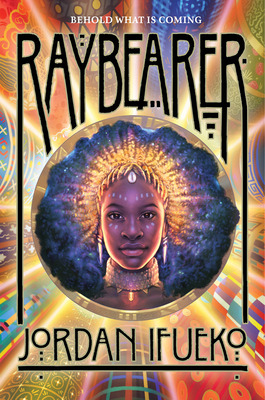
⭐⭐⭐⭐ 1/2
Tarisai has been raised from birth to excel, to rise above all others from her land to attain a coveted position on the Council of Eleven, and then to kill the crown prince. Bound by the circumstances of her birth to obey her mother's command, Tarisai is desperate to find a way to protect the prince she's come to love from the hidden threat that she herself poses. Will she be able to defy the destiny her mother has chosen for her?
I loved the worldbuilding here, particularly the depictions of the lands we got to visit and the themes of embracing unique cultures vs assimilation. There's a darker edge to many of the systems in this world, which I also appreciated. While the protagonist was rather unquestioning of some things that should have thrown red flags(basically everything about the council), this is only the first book of a duology, so those aspects might be examined later.
The central conflict is, of course, Tarisai's struggle to break free of her mother's command. I initially got some Ella Enchanted vibes from this setup, but the resolution wound up being so much more. It wasn't enough for her to merely want to disobey, or even to desire to protect the prince with her whole heart; to break a curse of this magnitude, it would take much more than that. I also appreciated how her mother was handled in the narrative. She wasn't purely evil, but she wasn't misunderstood either; she was a complicated, wounded character who committed great harms.
Overall, I enjoyed this a lot more than I'd expected to. It helped that the romance was firmly a subplot, and there was no love triangle. I'll say that again for those in the back: this YA title has no love triangle! It was so refreshing to see a depiction of platonic love develop between two characters. There was even a prominent character who was explicitly asexual. As mentioned, this is the first book in a duology, and I intend to pick up the sequel, Redemptor, whenever I manage to find a gap in my TBR(lol).
#books#book review#raybearer#jordan ifueko#ya fantasy#fantasy#afrofantasy#young adult#ya fiction#botb 2023
4 notes
·
View notes
Note
I get your recent post but struggling with accepting that there was anything good (like friendship or love) that came out of the war is also very much a theme in mash, especially in gfa
Yeah so in the longer, less coherent version of that post in my head, I also talk about how MASH undermines its own message by staying on for eleven years. And like, it's okay. I'm okay with it. But I think if you look at the original core message of MASH at the beginning, the idea of good coming out of the war is not there. I mean, in The Interview, Potter, one of the career military characters, is asked if he sees any good coming out of the war and says "not a damn thing." I think the cast's feelings as well as the audience's feelings are necessarily projected onto the characters after that long, and we're just attached to them and see their friendships as good, because our circumstance is watching them on TV. Not, you know, actually being in a war.
But even so, I think if you asked Hawkeye if he'd trade the friendships he made during the war to make it so the war never happened, he would not hesitate to say yes. Of course, you can't say yes, that's a dumb hypothetical, so what you get back to is these relationships that formed under horrible circumstances because that's life. But GFA still shows them all going their separate ways as the happy ending. I think it's notable that MASH doesn't have Hawkeye particularly grow as result of the war. His morality is in place from the beginning. Sidney tells him maybe his own pain will help him understand his patients better, but that's it.
One of the things that all depictions of war struggle with, including openly anti-war ones like MASH, is not showing it as good. If you want to show an individual character's development and you show them succeeding in life after the war, someone in your audience is going to decide it's because of the war. MASH does get into this somewhat and while I don't blame the show for it or necessarily think it's avoidable, I do think it's important to be aware. Some people do become better people as the result of traumatic events, but you don't want to say those events are broadly worth it. Charles pretty clearly becomes a better person when he's confronted with real suffering and forced to empathize with people unlike him. But Charles was kind of a bad person to begin with. Margaret is similar; she's spent her entire life in the army and believing in it, and maybe the war gives her a different perspective. But she wasn't a great person in the beginning, either. Neither of those, in my opinion, is comparable to a narrative of discovering one's true self.
My issue is, fanfiction, especially if its romance, usually takes a love conquers all stance whether it means to or not. If your fic is about a man realizing he's gay while serving in the Korean War and understanding his sexuality is ultimately a positive development in his life, you are, whether you mean to or not, sending the message that the war was a good thing. A good thing for him, but when the story is about him, that means a good thing. Particularly when the focus is on the queer journey or love story, because the bulk of what the audience sees is then the good thing that came out of the war. I don't think that's comparable to GFA, which focuses quite a lot on the destruction.
And I don't think most fic writers looking for queer wish fulfillment particularly explore the nuances of feeling grateful for the effect an objectively horrific event had on the main character's personal life. And I'm not taking a moral position on whether they should or not, it's simply that I want nothing to do with those stories.
4 notes
·
View notes
Text
I need a palate cleanser.
From a more positive position, I think putting forth a thesis for why sex and eroticism in fiction can be meaningful - not as a refutation to sexual violence, but purely on its own terms - is actually worthwhile. Because there should be a positive model to the acceptable depiction of 'sex' as rape, and that informing the archetypal dynamics of sexuality in storytelling. It's not like the model should be rape or nothing, objectification or nothing. People think you're trying to take away the only expression of their sexuality that they've got in this sort of topic, and I find it very weird, particularly in feminist spaces and the proshipping debate.
Again, my stance on proshipping/anti shit is that it's schoolyard bullying and moral nuance goes there to die. But on the other hand in my experience it's not like either side really tends to value positive expression of sexuality - it's only about exploring the most taboo (rape) and the other side trying to spin everything as rape because all sex and explicit content is bad. It's fucking bananas. I get that proshippers have their reasons for writing the really dark stuff but when it's done for barren textual purposes I just don't see the justification. Sure, I am not disputing AO3's policy, I just wonder whether it is always artistically defensible. Because that's basically my metric.
But I'm more interested in what eroticism offers storytelling. I think that there is plenty of dark stuff that has genuinely justified ideas - and I think that exploring violence and darker dynamics is not in itself unjustified and is in fact found uncritically in a lot of published literature - but the usual refutation is that I'm trying to police peoples' creative expression, especially in fannish spaces where don't like, don't read. But if I'm trying to find a personally valuable model for sexuality in storytelling, and I'm trying to identify my discomfort, and I'm trying to identify why I'm okay with some of it (I read a Gothic horror romance done very well once in fanficland) and some of it I'm not, then I actually want to consider how it lines up with my own personal conception of what sex (and darker themes related to that, even) achieves in storytelling. Clearly there is something workable here which doesn't play into anti schoolyard bullshit that isn't also thought-terminating 'but I enjoy it' type annoying refrain - which if I categorically reject as cultural criticism and as something which defends, say, the unrealistic, fetishistic depiction of rape, I don't see how I can entertain it in fanfic.
I don't have a personal issue with proshippers the way I do antis, and as I've said I nominally agree with that position. But I don't think it should be a conversation-ender.
As I gestured at, though, it's interesting that even the proshipping debate largely revolves around the taboo - rape, incest, so on and so forth - and not the expression of positive sexuality itself. I feel alienated in that sense, I suppose, but I also think from a position of argumentation - the antis are swift to decry sexuality, so why is it that we conceive of sexuality in proshipping circles as interchangeable with sexual violence?
1 note
·
View note
Text
fight club, fathers, franchises and ideal selves: a commentary on the absentee american dream
the first rule of fight club is to build a family according to a business model. the second rule of fight club is to blame your father.
brotherhood to fellowship to a hierarchy of space monkeys; this is the progression of antagonist tyler durden’s ‘project mayhem’ in chuck palahnuik’s 1996 book, ‘fight club.’ the anticapitalist cult classic of the late 90s entered the mainstream years after the release of david fincher’s 1999 movie adaptation. the book depicts late stage american capitalism and specifically a masculine reaction to it – the protagonist grows to resent his ‘lovely nest’ of belongings, realising he has very little identity outside of the ikea home he’s built for himself, and begins to spiral into a schizophrenic episode resulting in the destruction of his local, and eventually national economic structures. palahnuik’s ‘stream of consciousness’ style of writing gives us an insight to his unnamed narrator’s psychological decline, providing commentary not just on the events at work in the novel, but commentary of the wider context of american consumerism and men’s roles in it.
linking men’s identities with corporate positions even outside of work environments is a vital theme of the story that palahnuik establishes early on. this characterises the relationships between men as having a business-like aspect to it, as though they are mostly transactional. this is particularly applied to familial relationships, both within the text and within palahnuik’s own philosophies, and is attributed to american culture and attitudes. our narrator describes his absentee father’s patterns as very detached: ‘my dad, he starts a new family in a new town about every six years. this isn’t so much like a family as its like he sets up a franchise.’ this stems from the idea that instead of a person, you exist as product or a branding, or a company. fathers are often likened to high authorities in this text: ‘if youre male and youre christian and living in america, your father is your model for god. and if you never know your father, if your father bails out or dies or is never at home, what do you believe about god?’…‘how tyler saw it was that getting god’s attention for being bad was better than getting no attention at all. maybe because gods hate is better than his indifference.’ the connotations of ‘god’ in this excerpt grant the role of father a tremendous amount of influence, but also a kind of mythical element to it. in the context of corporate roles, this volume of power would put fathers at the top of the hierarchy, like ceos or company founders. actual ceos, or work bosses, serve as ‘secondary fathers.’ palahnuik explains this concept by referring to joseph cambell: ‘[joseph campbell] said that beyond a person’s biological father, people needed a secondary father — especially men. typically that was a teacher, coach, military officer or priest. but it would be someone who isn’t the biological father but would take the adolescent and coach him into manhood from that point. the problem is that so many of these secondary fathers are being brought down in recent history. sports coaches have become stigmatized. priests have become pariahs. for whatever reason, men are leaving teaching. and so, many of these secondary fathers are disappearing altogether. when that happens, what are we left with? are these children or young men ever going to grow up?’
fight club’s narrator introduces his job as something that he is disillusioned with. his insomnia combines the formulaic nature of his job and frequent travelling make it pass in a mindless blur. taking campbell’s theory into consideration here, it can be assumed that is ‘secondary father’, in this instance his boss, has failed him. readers later discover that his biological father, who creates new families like ‘[setting] up a franchise’, did not guide him either: ‘after college, i called him long distance and said, now what? my dad didn’t know. i got a job and turned 25, long distance, i said, now what? my dad didn’t know…i’m a thirty-year old boy.’ the narrator, sometimes referred to as readers as ‘jack’ or ‘joe’, presents himself as a relatively average representation of his demographic. this suggests that in answer to campbell’s question, ‘are these children or young men ever going to grow up?’, the narrator’s experience can be generalised. he often explains his emotions through a format found in old health magazines: ‘in the oldest magazines, there’s a series of articles where organs in the human body talk about themselves in the first person: i am jane’s uterus.’ ‘i am joe’s inflamed sense of rejection…i am joe’s wasted life.’ in fincher’s movie this is changed to ‘jack’, but the connotation of ‘average joe’ remains the same. in remaining unnamed, the narrator is an everyman, a broad reflection of masculine american culture that a readers of that demographic can relate to. in reaction to feeling like an adult child, tyler (and by extension the narrator, hereby referred to as joe) gradually work up from fight club to project mayhem, an all-male organised crime unit that functions similar to an army. while there are more details to project mayhem’s structure, it operates under a systemic hierarchy similar to that of a corporation, with departments and bosses. the core difference is that the ‘employees’ are not paid, and the unit operates not just outside of but against society, the headquarters beyond the edge of town, the members antagonising the public and authorities. initially the idea that tyler and joe have mirrored the corporations they aim to destroy seems ironic, but it does serve the pair a purpose. by founding this corporation-like project themselves, tyler and joe create founder or ceo roles for themselves. this places them at the top of the hierarchy, allowing them to experience the power of the men who failed them (namely bosses and absent fathers). project mayhem seems to naturally take on this structure, despite being separate from american society. implicit in this is the suggestion that power structures are not just ingrained in american capitalism, but in modern masculinity. the masculine response to controlling powers in this text was to take over the controlling powers yourself; while project mayhem’s aim is framed as dismantling regional, and eventually national, capitalistic authorities, it transpires that tyler and joe shift this power to themselves, even if it is only within the context of this obscure group and its branches in other states.
palahnuik, in response to the suggestion that fight club is a gendered text, states that ‘it was more about the terror that you were going to live or die without understanding anything important about yourself. in the book it does directly criticise capitalism’s impact on everyone: you have a class of young strong men and women, and they want to give their lives to something. advertising has these people chasing cars and clothes they don’t need. generations have been working in jobs they hate, just so they can buy what they don’t really need.’ this sentiment is abundantly clear in the text, both thematically and in some chapters, said explicitly. fight club is renowned for its anti-consumerist rhetoric, however its predominantly male cast of characters, and overt comments specifically on the relationship between american consumerism and masculinity does make the book a gendered working critique of capitalism. pahalnuik rarely addresses feminine responses to advertising and corporate employment, and it is certainly not central to the narrative in the way that masculinity is. the author’s other works, namely adjustment day (2018) follows a similar theme. it depicts an armed insurrection that overturns american society. this insurrection is triggered by a corrupt senator’s plans to draft young men, with the intention of letting them die in a planned nuclear attack in the middle east, preventing those same men from staging an uprising. these american men, upon discovering the plot, rise up and kill figures the public have voted online as most deserving to die before the vote to reinstate the draft, and become the united states’ new leaders. this echoes sentiments from fight club, particularly those surrounding the suppression of young men, and the idea of taking power for yourself rather than dismantling power structures altogether. whether intentionally or not, palahnuik focuses on a gendered reaction to american society, with his discussions targeting the culture’s obsessions with consumerism and war.
while the military and advertising culture are staples of the united states, these are not entirely at the frontline of the ‘american dream.’ in fight club 2, the narrator is seemingly living the american dream, characterised by white picket fences, a wife, a child, and so on. despite outwardly living a life sought after by many, joe remains unfulfilled. palahnuik describes this by musing, ‘it’s funny, it isn’t the process of getting stuff, it’s the stuff itself that becomes the anchor. it’s ‘buy the house, buy the car’ and then what? it’s that isolated stasis that’s the unfulfilling part you ultimately have to destroy. that’s the american pattern — you achieve a success that allows you isolation. then you do something subconsciously to destroy the circumstance because you can come down into community after that.’ this mimics motifs from the original fight club, in which the narrator discusses ‘[wanting] to destroy something beautiful’ as a form of catharsis. ‘i wanted to destroy everything beautiful id never have…i wanted the whole world to hit bottom.’ interestingly, a piece of media that conveys a similar point of view on the american dream is the song ‘once in a lifetime’ by the talking heads. it’s argued that the disconnection david byrne describes is reflective of an autistic view on the world. however it does echo the lack of fulfilment the advertised ‘american dream’ can provide. byrne sings, ‘and you may find yourself behind the wheel of a large automobile / and you may find yourself in a beautiful house, with a beautiful wife / and you may ask yourself, ‘well how did i get here?’ the song is punctuated by a chorus that repeats the line ‘letting the days go by, let the water hold me down.’ the drowning motif used here is often used in conjunction with feelings of unfulfillment or dissatisfaction, as is reflected in fight club 2 and other similar media. at the start of fight club the narrator feels the same way, insomnia blurring his job and ikea home and work commutes into one dissatisfying experience: ‘this is your life, and its ending one minute at a time…you wake up, and you’re nowhere.’ the destruction of something outwardly desirable, such as blowing up joe’s perfectly curated and furnished apartment, breaks him free of this.
tyler is almost drawn as the antithesis to joe to begin with. there is one key device that demonstrates this; marla singer. it is, of course, incredibly reductive to refer to a female character as a ‘device’, and marla exists to add more to the plot than just illustrating the narrator and tyler’s relationships. however, the distinction between how marla receives joe and how marla receives tyler is significant in charactersing the two of them. for the narrator, marla initially acts as a mirror: ‘her lie reflected my lie…to marla i’m a fake.’ upon meeting marla, the narrator immediately dislikes her because her dishonestly disrupts the benefits he gets from his own dishonesty. they both use these support groups to invoke more feeling in their otherwise dull or flattened experiences; palahnuik describes this by stating that ‘in fight club the [support] groups showed up to create life by being present to death, imminent death.’ for joe, being surrounded by hopelessness, ‘rock bottom’ allows him the emotional release that tires him out enough to cheat insomnia. for marla, the groups are a continuation of her fascination with death, a step up from working at funeral homes; ‘‘funerals are nothing compared to this,’ marla says. ‘funerals are all abstract ceremony. here, you have a real experience of death.’’ ‘she actually felt alive…all her life[…]there was no sense of life because she had nothing to contrast it with.’ in contrast, marla’s relevance to tyler seems predominantly sexual, and the early stages of their relationship are described bluntly and graphically: ‘one morning, there’s the dead jellyfish of a used condom floating in the toilet. this is how tyler meets marla.’ marla’s insistence on speaking with joe seems nonsensical to him, as he was not mentally present during his sexual encounters with her, and tyler’s insistence that joe not tell marla about him draws a sharp contrast between each personality’s relationship to her. ‘ok. you fuck me, then snub me. you love me, you hate me. you show me a sensitive side, then you turn into a total asshole. is this a pretty accurate description of our relationship?’
marla arguably becomes the middle man for highlighting any homoeroticism between joe and tyler, illustrated by joe’s jealousy. joe is not jealous of tyler for having relations with marla, but the other way around. he asks, ‘how could i compete for tyler’s attention. i am joe’s enraged, inflamed sense of rejection.’ towards the movie’s end, upon the reveal that tyler and joe are one person, tyler says ‘all the ways you wish you could be? that’s me.’ this indicates that the jealousy was more centred around his own insecurity, but joe desires tyler’s attention specifically, alluding to a relationship between them. this obviously becomes somewhat dangerous territory here as the pair are technically one person, so a relationship between them would be somewhat incestuous but even in one body they seem like two entirely separate people, if not just in terms of physical appearance. in fincher’s movie adaptation, tyler (brad pitt) and joe (edward norton) share bottles and cigarettes with one another after fighting, fincher’s subtle way of painting physical violence as potentially sexual or intimate. this is illustrated in this moment from the film’s commentary that occurs after the initial fight between the pair: [tyler takes a sip from the bottle] fincher: i love the post-coital smoke. pitt: it’s touching.
the relationship between a man, in this case joe, and his ideal self, tyler, has this intense charge which can obviously be mistaken to be sexual; it is arguably more in tune with the narrative to consider that this intensity is centred around ideas of control. joe is intended to represent that average american man, suggesting that palahnuik is using him as a vehicle to discuss the feeling of incongruence in men in this era. humanist psychologist describes incongruence as ‘unpleasant feelings…result[ing] from a discrepancy between our perceived and ideal self.’ essentially, the root of joe’s boredom and distress can be found in the differences between him and tyler. the tense bond between them lies in the struggle for control; the novel personifies the ideal self and depicts a hypothetical scenario in which this ideal self seizes the autonomy of the individual in order to achieve congruence (an overlap between the perceived and ideal self). congruence is the aim of humanistic psychotherapies. by helping an individual feel less distant from their goals and aspirations as a person one can be more content in themselves. what tyler does in this novel is an extreme reaction to the feeling of incongruence. his reaction encourages the men around him, in both fight club and project mayhem, to change their ideal self from the men they see in adverts to something less ‘self-indulgent’ and take control of their lives to achieve it. ‘we’ve all been raised on television to believe that one day we’d all be millionaires, and movie gods, and rock stars. but we won’t. we’re slowly learning that fact…you are not special! you are not a beautiful or unique snowflake!...it’s only after we’ve lost everything that we’re free to do anything.’ in taking these men out of the public sphere and creating an entirely new environment separate from capitalistic society, each member’s ideal self becomes less influenced by advertising, television, and so on, and they are given the space to achieve congruence without societal obstacles such as jobs and families. when taken outside of regular society, these influences begin to have less effect on our identity: ‘you are not your job.’ however, project mayhem still functions similar to an army division or a cult, with its own specific hierarchy designed to suit tyler’s agenda. the congruence between tyler and joe is prioritised over all else given the intense battle over which of them is able to control the body; their combined attempt to maintain their ideal self in some way or another is the most visceral of all the characters, and is the main trigger for the events of the text.
fight club, as a piece of text, essentially functions as social commentary, through the lens of one ‘everyman’s’ neurochemical drama. joe’s struggles are specific to his role in society and his interactions with consumerism, which are depicted in a way that makes them applicable to much of his demographic: in this case, white men in 1990s america. palahnuik creates a narrative that forces the narrator to experience a push and pull effect between his real situations and ideal ones, to the point of creating something entirely separate. his experiences serve as a clear critique of capitalism and its inverse relationship to masculinity. the narrator’s identity warps and changes depending on his roles within, or distance from, consumerist structures. palahnuik’s motif of experiencing events the way one does an aeroplane ride continues throughout joe’s narration, emulating the switches from boredom to terror to acceptance that one experiences in such a structure: ‘we have just lost cabin pressure.’ the participants of fight club represent the usa’s disillusioned youth, their attitude to their jobs, their anger, and their failing desire to participate in capitalism any further. ‘may i never be complete. may i never be content. may i never be perfect.’
i.k.b
#fight club#fight club analysis#literary analysis#movie analysis#film analysis#critical essay#long post#fight club movie#fight club book#chuck palahniuk#david fincher#textpost#analytical essay#books and literature#90s films#film#favourite movies#movies and tv#cult classic#cult film#capitalism#consumerism#masculinity#anti capitalism#anticapitalist lit#tyler durden#marla singer#brad pitt#edward norton#helena bonham carter
104 notes
·
View notes
Text
Asteroids Part 6; Sisterhood of Pallas Athena, Symbolism of the Asteroid Pallas Athene
Part 1 Part 2 Part 3 Part 4 Part 5

The long overdue sixth part of my asteroid series is finally here.
The asteroid Pallas Athene is one of the more prominent asteroids covered in the astrological community thanks to Demetra George’s “Asteroids Goddesses; The Mythology, Psychology, and Astrology of the Re-emerging Feminine.” In this part, I will cover the asteroid’s symbolism and interpretation based on mythology, gathered research from authors such as Demetra George, and my own knowledge.
The ancient Greek goddess Athena may have been synonymous with the Egyptian goddess Neith and possibly other earlier known goddesses. Throughout this asteroid series ( and just in general for my astrological interpretations) I’ve tried to peel back further from Greek origins and more toward Kemetic or Sumerian origins for a pure and truly ancient understanding of asteroids named after Greek deities. However, I’ve accepted that for Pallas Athene, the Greek mythologies derive important symbolism that just isn’t clearly depicted from what we know of Neith or other earlier goddesses synonymous with Athena.
The Mythologies of Athena
Athena is the goddess of war and wisdom. She was revered by gods alike and those who worshipped her for her remarkable strength, courage, wit, and creativity. Her birth story begins with Zeus swallowing the titan Metis who was carrying the unborn Athena. After some time had passed, Zeus develops a headache that would only be cured by Hephaestus’ splitting open his skull. Out from Zeus’ skull Athena is born as a fully grown woman encompassing all of her remarkable traits. Athena was Zeus’ favourite child, for she was his creation; so purely in his image of goodness, power, and wisdom.
Like Vesta (or Hestia), she is a virgin goddess, she serves herself and is whole with herself. Though, she had a friend who she quite possibly could have been in love with and she did love; Pallas.
Athena and Pallas
Pallas was the daughter of Triton. She was equal to Athena in wisdom and the art of war. They were partners in battle and one day the gods were disputing which of the two goddesses were stronger. So the two goddesses sparred and Zeus interfered allowing Athena to have the upperhand. Unfortunately this ended up fatally wounding Pallas. Athena was so heartbroken that she added Pallas’ name to her own to honour her. While it is never mentioned in the myth between these two goddesses, I speculate the possibility that their relationship may have been more, possibly as lovers in war. In ancient Greek and Roman times, it was a known practice that soldiers would often become romantically involved with one of their peers, even if they had a partner back at home. This was because they believed you would fight better for someone you love, especially if it was to avenge the death of a lover.
Athena and Medusa
While there are several interpretations of this particular myth, the one that I find significance with is the one that describes Athena aiding Medusa.
Medusa was said to once be a very beautiful woman who made a vow for herself to remain virginal. However, her beauty drew on the male gaze and she was preyed upon against her will. The ocean god Poseidon tried to have his way with Medusa, but Athena stepped in and transformed Medusa into an ugly creature with snakes for a head of hair, and anyone who looked into Medusa’s eyes would turn stone.
This myth often depicts Athena as jealous of Medusa’s beauty, but in truth, this would be extremely out of character for Athena who’s not concerned with how others perceive her, particularly men. Athena cloaks Medusa with ugliness as a defense– as a way to protect Medusa from unwanted attention. This myth parallels greatly with the internal struggle many people have, particularly women, with the threats and vulnerability that coincide with embracing beauty and femininity.
Helper to Heroes
Athena often makes appearances in myths about a hero’s journey and aids the hero in some way. She often has some sort of valuable foresight or tool to give the hero. Mortals look to her for her strength, wit, and strategy.
The story with Medusa continues as Athena actually aids Perseus upon hearing he needs to take Medusa’s head. She gives him a reflective shield so he can see Medusa without looking into her eyes and turning to stone. Many of the common interpretations of this myth state that Athena hated Medusa which is why she was so willing to help Perseus on this quest. However, following the interpretation I mentioned where Athena turned Medusa into a gorgon for her protection, Athena would have been the only one to understand the circumstances of Medusa. In addition to this, in the myth itself Medusa plays more-so as a symbolic prop instead of a character. Particularly because Medusa as a gorgon is described as having snakes for hair– snakes in myths can (but not exclusively) symbolize treachery and bad spirits needing to be expelled. We see this in stories like Inanna and the Huluppu tree where people often confuse “lilītu” with the actual archetype or character Lilith; there was no Lilith in that story, just spirits needing to be expelled from a tree.
The Seer
Athena is often described by poets as being “grey-eyed” and there is symbolism behind this. According to Wikipedia the choice to describe her this way is quite deliberate; “In Homer's epic works, Athena's most common epithet is Glaukopis (γλαυκῶπις), which usually is translated as, "bright-eyed" or "with gleaming eyes". The word is a combination of glaukós (γλαυκός, meaning "gleaming, silvery", and later, "bluish-green" or "gray") and ṓps (ὤψ, "eye, face"). It is interesting to note that glaúx (γλαύξ, "little owl") is from the same root, presumably according to some, because of the bird's own distinctive eyes.” Athena is also often depicted as or with an owl which is all deliberate symbolism of her wisdom, keen perception, and foresight. There is a seer quality about Athena that is tuned into aiding justice and heroism.
Themes of the Asteroid Pallas Athene
Fear or repulsion of feminine expression in oneself
Deconstructing heteronormativity
Equality, democracy
Psychic vision, foresight
Companionship, sisterhood, brotherhood
Same-sex experiences, perceptions, and empathy
Creative vision
Justice
Intellectual power
Maternal absence
Pallas Athene being an asteroid, only with prominence in the birth chart will her themes and the complexes arising out of those themes be noticeable. Otherwise, Pallas Athene in one’s birth chart demonstrates where one tends to have strategic foresight/vision, where one meets Pallas Athene-like characters, and where one is called to serve justice.
Aspects to Pallas Athene
Sun-Pallas Athene
In hard aspects, such as a square or opposition, this contact can be quite troublesome and makes for complexes the individual will have to fight to overcome. The difficult aspects signify negative experiences with the paternal figure in their life which translates over into adulthood as having distrust in and difficulty with men. As most societies are patriarchal, these aspects tend to be harder for feminine identifying individuals. These individuals are keenly aware of the violence that can coincide with objectification, particularly the objectification of feminine expression. When this type’s innate identity is objectified, defences are put up and they reject and conceal their expression. Being viewed in a sexual nature in an unwarranted way kills the confidence in these individuals; it conflicts with how they view themselves as an entire being and their purpose. Being comfortable with one’s sexuality can be an issue in the more difficult aspects with this contact as well; there may be shame, repulsion, or rejection of one’s sexuality. To aid these complexes, therapy as well as companionship and empathy from people who share the same experiences or trauma is beneficial.
In positive aspects, such as a trine or sextile, we see the opposite of the crippling experiences in the negative ones. These individuals tend to be comfortable and even celebratory in either binary expression; they are often quite androgynous. They are also quite comfortable in their sexuality as well as they are firm believers in dismantling gender roles and heteronormativity. These individuals are fighters for people with Pallas Athene complexes and injustice in general. They have a tremendous amount of strength, empathy, and willingness to understand gendered, sexual, and political issues. These individuals can find their life’s purpose, fulfillment, and accomplishments through their intellectual creativity.
The conjunction brings out Pallas Athenian archetype within one’s character. These individuals will be very Pallas Athenian in that they will see within themselves the complexes that arise from both the positive and negative aspects. They often have quite a strong presence, cunning intellect, and the foresight vision.
Moon-Pallas Athene
In positive contacts, these aspects bring out the psychic nature of Pallas Athene– Pallas Athene’s foresight and the wisdom in part with that. These individuals are empaths and healers. In the positive aspects, this is Pallas Athene reconciled with the fact that she never knew her mother; in individuals, it is a deep connection with the maternal expression within them (through a Pallas Athenian lens) or a deep connection with the maternal figure in their life. The maternal figure in their life may have been very Pallas Athene-like or could have been a contributor to giving the individual the strength, wit, and wisdom that matches Pallas Athene’s archetype. Creative vision is evoked by emotional exploration
In negative aspects, such as the square or opposition, there can be an absence of a maternal figure. Just like Pallas Athena herself, this individual may have been raised by their father with their father’s interests on the forefront. As a result, feminine expression is often null or even despised or feared. These individuals may repress their emotions surrounding their own gender or sexuality issues. They can be quite defensive and unless the Sun has prominence in the chart, they can also disguise their expression and true identity. These individuals can be quite masculine, over-functioning, and independent; they fear depending on others and self incompetence. To aid these complexes, they need to surround themselves with people that can bring out the softer nature hiding within them; they need to see that being nurtured and loved does not diminish their strength and ability.
The conjunction brings out complexes that resemble both the positive and negative aspects, though the maternal figure is most often present like in the positive contacts. Psychic vision is very potent with the conjunction and there is an urge to serve justice with it.
Mercury-Pallas Athene
In positive aspects and the conjunction, we see individuals with immense creative intellect. These people are often leaders in the fields of science, art, politics, and law. People look to these individuals for their ability to strategize and look at the whole picture. As Pallas Athene touches the planet of communication, these individuals will often have a powerful voice, especially for those who don’t and are in need of justice. They can make for great advocates for gender and sexuality issues.
In the negative aspects, such as the square or opposition, we see individuals who struggles to have a voice on gender and sexuality issues, or just in general. These people can find their voice by making connections with others who share similar issues and by being part of a group setting.
Venus-Pallas Athene
The Venus contacts to Pallas Athene can be quite similar to the Sun contacts in that the complexes surrounding feminine expression tend to be the same. In the negative aspects, such as the square or opposition, there is the same repulsion towards feminine expression in oneself. It stems from fears developed from observing a patriarchal society’s perception of women and sometimes trauma. There may even be internalized misogyny present as these individuals have a tendency to reject traits that could be perceived as feminine, as they equate femininity to weakness and incompetence. These individuals present themselves as tough, rigid, unlike the others, and often androgynous or hyper masculine. They fear being taken advantage of and avoid any sign of weakness at all costs. Their inability to let their guard down can hinder close relationships; these people often deny themselves of romantic connections and keep everyone at arm's length. To cope, these individuals will put all of their focus into creative outlets and put their accomplishments on a pedestal over relationships. To aid rigidity and to reconnect with feminine expression, these individuals need to surround themselves with strong figures who are very confident in their feminine expression; they need role models and will find strength in numbers (being part of a support system). Re-education may need to be involved in the healing process as well. Exploring further with where ever Venus is in the individual’s chart and honing in on Venusian activities can really benefit this individual’s self acceptance, inner beauty, and sexuality.
In the positive aspects, such as the trine or sextile, there is radiating confidence, beauty, strength, creativity and merging of masculine and feminine energies. In these aspects is where Aphrodite and Athena meet eye to eye. These individuals are often very comfortable in their sexual expression; they tend to be drawn to feminine energies. As Pallas Athene aspects tend to make for, these individuals also tend to be express themselves androgynously, but are comfortable with feminine expression. They are very celebratory over it, similar to the Sun aspects. These individuals tend to be quite independent, but definitely not closed off. There is often an urge to utilize their strength and confidence in advocating for women’s right and issues, and it should be encouraged as these individuals are often the perfect candidate to advocate on these issues. These individuals possess some healing abilities as well and heal others through empathy. Empathy for same-sex experiences is a prominent theme for both the positive and negative aspects; the natural connectivity or alliance with one’s gender makes them feel protected and valid.
With the conjunction, many of the themes found in the Venus-Pallas Athene aspects are intensified. Pallas Athene is somewhat personified in the individual and there is a much more radical need to demonstrate their autonomy over how they choose to express themselves. Expressing themselves through creative means is often very important and almost always contains a very Pallas Athenian message.
Mars-Pallas Athene
In positive contacts, such as a trine or sextile, Mars emphasizes that accomplishments and success can be found through Pallas Athene. Individuals with these aspects make excellent leaders, people want to nominate this type of individual to be in control and make the decisions. These individuals have a lot of drive, strength, and prestige, as well as empathy and compassion that does not diminish those qualities. There’s a keen awareness for underdogs and an urge to aid those beneath them. In feminine identifying individuals, utilizing masculine traits yields success, and in masculine identifying individuals, utilizing feminine traits yields success. Strong, lifelong companionship with the opposite sex is a common theme with these aspects as well.
With negative aspects, such as a square or opposition, there can be intense strife with the opposite sex. Additionally, strife with one’s own gendered expression; either hyper masculine or hyper feminine to conceal one side of the binary. Much of the repulsion towards one specific expression is due to societal conditioning as well as upbringing; it’s a defense mechanism to protect themselves from being perceived as either too weak or too harsh. There can be a lot of anger within the negative aspects as well; it would be best to redirect this anger towards a cause, such as advocating for women’s rights, men’s mental health support, protecting children (particularly if the 5th house is involved), environmentalism, sexual freedom, religious freedom, and so on. Therapy and support groups can aid self resentment and resentment towards the opposite sex.
With the conjunction, Pallas Athene is personified in the individual when they are challenged or angry. They may be quite radical, independent, and domineering; they are always in charge. They despise being perceived as incompetent or submissive. Pallas Athene’s strategic and cunning qualities are apparent in the conjunction as well; these individuals are not people you can fool or surpass, especially when a goal is on the line.
Jupiter-Pallas Athene
In all Jupiter contacts, Pallas Athene’s psychic foresight is present. Individuals with these aspects are blessed with intuition and wisdom. They hold valuable advice and counsel to others as well as themselves. They tend to be respected by many; their companionships and kinships are their armies.
Particularly in the positive aspects and the conjunction, these individuals would do well in politics, law, and creative arts. Serving justice is particularly important to this asteroid when in contact with Jupiter. Symbolically Jupiter is Zeus, Athena’s father, who loved and praised Athena the most out of all of his children. This may translate as an individual who had a similar positive relationship with their father; a father who is particularly proud of the individual, who may also could have been quite Jupiter-like. It also signifies the urge to be the same type of parental figure to their own children.
Saturn-Pallas Athene
With positive aspects, such as a trine or sextile, there is creative focus and prestige. The hard work from these individuals doesn’t go unnoticed. Saturn amps up Pallas Athene’s urge to serve justice; there’s often feelings of responsibility over something as big as society. These individuals would do well in law, politics, or any position of leadership. Reconstruction of societal values is a common theme with these aspects. These individuals seek change for how society perceives gender expression, sexuality, and politics. On a different side of the same coin, these individuals may have a bit of rigidity within themselves when it comes to true self expression, particularly with expressing femininity. Though, the negative aspects are considerably more stark than the positive.
With negative aspects, such as the square or opposition, there is almost always issues with the paternal figure or one of the individual’s parental figures (particularly if one parent is a stern, overfunctioner). The individual may have had high expectations held against them at a young age or there may have been a preconceived notion from a parental figure that the individual is incompetent due to how the individual expresses themselves or based on the individual’s values. The individual will feel inadequate to their peers, especially to a specific sex. There is rigidity in their expression, as mentioned earlier. These individuals may overcompensate for gendered stereotypes inflicted upon them. These individuals need to redirect their purpose for themselves and not for others. Therapy may aid them in relearning that they are not put on this planet to meet someone else’s expectations. Once confidence is regained, they can reign the creative focus, prestige, and leadership qualities that the positive aspects signify.
The conjunction can demonstrate qualities from both the positive and negative aspects and is much more potent and noticeable out of all of the Saturn aspects.
Uranus-Pallas Athene
In all Uranus-Pallas Athene contacts, there is an urge to come together with people to make change. Here is where Athena builds her army and strategically conquers and destroys harmful constructs. The aspects with Uranus are all about world betterment, particularly with issues dealing with gender and sexuality.
In positive aspects and the conjunction, Pallas Athene’s geniusness is very apparent. Individuals with these aspects often find success in sciences or anything that utilizes creative intellect.
Neptune-Pallas Athene
In all Neptune-Pallas Athene contacts, individuals can find access to psychic power and strong intuition. These individuals have dreams of prophecy and can see far into the future. These individuals also tend to have a knack for arts that require a lot of technicalities and vision such as music and film.
People with the conjunction may find their psychic powers to be particularly potent and these people are often very spiritually aligned. Their binary expression has special importance to their spirituality. Spiritual devotion is merged with their self expression; whether that be the type of spirituality they practice or perhaps a special relatability to specific deities or energies.
Pluto-Pallas Athene
These aspects are most apparent when it’s the conjunction or accompanied with a personal planet. These aspects give an individual the urge to really explore the psychology behind Pallas Athene complexes. There is dedication to understanding difficult constructs, particularly gender, sexual, social, political constructs. This urge is accompanied with the desire to transform the world’s beliefs, similar to the Uranus aspects.
In negative contacts, these aspects can signify this urge stemming from a place of trauma and wanting to heal and rebuild the self.
Pallas Athene conjunct or in the house of the Ascendant
Athena is personified in the individual. These are people of strength, prestige, wit, and beauty. They possess the creative vision this world needs. These people break societal norms through their self expression and defy gender and sexual stereotypes.
Pallas Athene conjunct or in the house of the Imum Coeli
Here the asteroid is quite concealed as it is furthest away from the spotlight (midheaven) and squares the ascendant. These people tend to not outwardly express Pallas Athenian qualities unless certain aspects demonstrate otherwise. Pallas Athene’s psychic qualities are more awoken here as the individual identifies Pallas Athene inwardly.
There may be a very Pallas Athenian person in this individual’s family or they are somewhat of a Athena-archetype themselves to their family (most loved child, most outspoken, known for creative intellect, etc.)
Pallas Athene conjunct or in the house of the Descendent
These individuals encounter or even draw in many Pallas Athenian-like people. Either that because they are drawn to these types of people or their projection out into the world brings them about as a way of balancing the individual or teaching them something they don’t see within themselves. These individuals tend to have a particularly fondness (platonic, romantic, or sexual) to their own gender.
Pallas Athene conjunct or in the house of the Midheaven
Here the asteroid is furthest away from home (Imum Coeli) and squares the ascendant. These individuals may possess some of the complexes Pallas Athene signifies on gender and sexual expression. There may be maternal absence and there is almost always a hyperfixation on career and success over relationships. These individuals are often the leaders in their workplace, if not, they still walk to the beat of their own drum and tend to be well respected. They may confuse the respect they earn by how they express themselves rather than their actual accomplishments. This can cause some difficulty around being true to oneself in terms of self expression. They need to seperate who they are being a factor in what they can accomplish and be known for.
© - @star-astrology 2021 / All rights reserved.
431 notes
·
View notes
Text

Since the very conception of the motion picture, the LGBT community have been represented on-screen in some form. An early example is Algie the Miner (1912), a short silent film which follows the effeminate Algie (Billy Quirk), who enjoys kissing cowboys. In order to marry someone’s daughter, he heads west to prove that he’s a man. While this is quite an outdated stereotype of being gay, the portrayals have varied greatly over time. Only recently is LGBT representation becoming more positive and common. However, when it comes to portraying bisexuality on-screen, it still seems to be a difficult task.
Many narrative tropes have been birthed through filmmakers trying to show sexuality on-screen and most of them contribute directly to the overall erasure of bisexuality in cinema – usually with ambiguous portrayals, negative stereotyping and characters needing to pick a side. Not all instances are problematic, but their prevalence isn’t helping to combat the stigma that bisexual people face. There are three main tropes when it comes to depicting bisexuality, which is infidelity, picking a side, and the horrible husband. They’re usually found together in a common narrative that erases bisexuality, whether intentional or not.
Infidelity
There’s a long-standing stereotype that bisexual people are more likely to cheat on their partners and are incapable of commitment. This is a trope that is heavily carried in some of the most well-known depictions of bisexuality. Typically, a female protagonist is engaged or married to a man, but she meets a lesbian woman and they become involved sexually and romantically, leaving the protagonist torn between two lovers. This happens in Imagine Me & You (2005) when Rachel (Piper Perabo) falls in love with lesbian flower shop owner Luce (Lena Headey), who provided the flowers for her wedding to Hector (Matthew Goode). It’s a fairly average film that could’ve been amazing had it acknowledged Rachel’s bisexuality, but it’s still one of the better ones considering Perabo and Headey have amazing chemistry.
For some reason, bisexual characters are often in serious relationships when they’re suddenly sexually awakened. This happened to Rachel right after her wedding because she happened to meet the right woman. While this type of experience does happen in real life, it’s always the go-to narrative for films about women realizing they’re not one-hundred-percent straight. In these instances, the same-sex love affair acts as the conflict within the narrative – this can create good drama when done right, but it gets boring and bisexual characters deserve better than constantly being portrayed as cheaters. People are not more promiscuous or likely to cheat on their partners because of their sexuality, but these tropes are constantly telling people otherwise.
We deserve to see bisexual characters whose sexuality isn’t the main narrative focus or who at least explore their sexuality outside of a relationship. Appropriate Behaviour (2014) is a good example of this as Shirin (Desiree Akhavan, who is also the film’s writer and director) is a bisexual Persian American woman who is keeping her sexuality a secret from her judgemental family, while also attempting to rebuild her life after breaking up with her girlfriend. Seeing bisexuality portrayed on-screen is another place where people pick up more stigma or acceptance, and with bisexuality it, unfortunately, seems to be the former. This is why bisexual filmmakers like Akhavan are better suited to portraying the experiences of bisexual men and women than others.
Picking A Side
When the protagonist is in conflict with her sexuality, the people around her usually wonder if she’s a lesbian now – despite them being engaged or married to a man. This can be seen in Below Her Mouth (2010) where Jasmine (Natalie Krill) begins having an affair with Dallas (Erika Linder). When her husband finds out, he tells her “You’re a lesbian” but she tells him that she loves him and nothing has changed between them. It seems impossible to grasp that a person could be attracted to both men and women. Bisexuality is erased.
Some films insinuate that the protagonist isn’t necessarily bisexual or even a lesbian, it’s just that they’re attracted to this one woman only and no others – they’re an exception! This is the kind of impression you get from Below Her Mouth, but also from other films such as Imagine Me & You and Elena Undone (2010), which isn’t particularly helpful for lesbian representation either. In Imagine Me & You, Rachel tells Hector “You are my best friend. That was enough before, and it will be enough again.” This implies that Rachel was never truly attracted to him in a romantic sense, thus implying that she’s a lesbian. While this could be a case of compulsory heteronormativity, it seems problematic as it’s never discussed or explained. Avoiding discussions about sexuality – as most of these films do – are what contribute to this trope massively and result in misinterpretation and erasure.
Films as new as Netflix’s Alex Strangelove (2018) also feed into the idea that bisexuality is a stepping stone to picking a side. Alex (Daniel Doheny) prepares to lose his virginity to his girlfriend but finds his plans derailed when he’s attracted to another boy. He spends most of the film questioning his sexuality and at one point thinks he’s bisexual. The film does highlight biphobia which brings attention to this problem, so it’s disheartening at the end when Alex realizes he is gay and not bisexual after all. The set up for Alex Strangelove was perfect for a bisexual love story and, while it’s still positive LGBT representation, it’s a shame it didn’t stick with that. It’s even rarer to see bisexual men portrayed on-screen, so it would’ve been really rewarding.
It’s important to acknowledge that bisexuality is a comfortable place for some people to be while they’re trying to accept that they are gay – and there’s nothing wrong with that. However, there still seems to be some widespread discomfort when it comes to sexuality being fluid. For bisexual people, there isn’t any side to pick – they’re not torn between polar opposites, nor are they confused. They aren’t on the fence, they’re on both sides of the fence. Nevertheless, films continue to portray bisexuality as a personal conflict that needs resolving, and it does this by putting bisexual characters in a situation where they’re having affairs. This makes their sexuality the narrative conflict, which is wholly problematic in itself.
The Horrible Husband
The protagonist’s fiancé or husband is usually abusive or passive in the relationship, and thus portrayed as the antagonist. She is then drawn to a lesbian woman who treats her so much better and gives her the attention she deserves. Sometimes it’s as though these films are saying that lesbianism is the cure for a dissatisfying heterosexual relationship. This contributes to bisexual erasure by suggesting that bisexual women can only be happy with women and never with a man because they’re horrible or not good enough. It also perpetuates the idea of picking a side – almost telling bisexuals that they should just be lesbians instead.
This trope is found in films like Elena Undone, where Elena (Necar Zadegan) meets Peyton (Traci Dinwiddie) who is a famous lesbian writer. Elena’s husband Barry (Gary Weeks), however, is a homophobic pastor. Elena Undone is actually loosely based on director Nicole Conn’s real-life romance with Marina Rice Bader, but the film itself isn’t great. It’s also shown in The World Unseen (2007) as Miriam (Lisa Ray) quietly follows the customs of 1950s South Africa, alongside dealing with her abusive husband Omar (Parvin Dabas). Miriam becomes empowered to change her circumstances when she meets and falls in love with free-spirited cafe owner Amina (Sheetal Sheth).
A much better film that deals with this trope is Bound (1996). Lesbian ex-con Corky (Gina Gershon) arrives at an apartment building to start work as a painter and plumber. She soon finds herself being seduced by Violet (Jennifer Tilly) who lives next door with her boyfriend Caesar (Joe Pantoliano). Violet explains that they’ve been together for five years and he’s a money launderer for the mafia. She wants to escape and make a new life for herself, so she and Corky plan to steal $2 million of Mafia money and blame it on Caesar. The horrible husband trope actually works well in this film because the women plan to screw Caesar over and it doesn’t use Violet’s infidelity as the main narrative conflict – it’s a lot more original, which isn’t surprising as the first directorial feature film from the Wachowski Sisters. Bound would’ve been much less effective if Caesar was just a regular guy who Violet hated, but she has a better motive with the drama surrounding his violent mafia connections.
These three tropes are collectively the entire plot of Imagine Me & You, Elena Undone, The World Unseen, I Can’t Think Straight (2008), Kiss Me (2011) and more. It’s a shame that there isn’t always a huge focus on the actual relationship between the two women in these films. It’s more about them hiding their relationship and because they officially get together at the end, we never get to see much of what their life is like as a couple. They all feature very similar themes, meaning that when it comes to telling the stories of bisexual characters, the narrative is rarely diverse. Romantic comedies in general always follow the same beats which is fine, but these tropes for bisexual characters either erase their sexuality and/or display it as a problem.
These tropes can still work well (like with Bound) depending on certain aspects of the narrative. Infidelity works well in Carol (2015) due to the 1950s setting. Carol (Cate Blanchett), who is in the process of divorcing her horrible husband, and Therese (Rooney Mara) have to hide their relationship due to homosexuality not being accepted during this time. This adds an extra layer to the narrative, giving actual depth to why things are happening the way that they are. There’s also Disobedience (2017) where it works well due to the Orthodox Jewish culture. Ronit (Rachel Weisz), who is considered bisexual, returns to the community for her father’s funeral to find her childhood friend Esti (Rachel McAdams) married to a man. Esti describes herself as a lesbian woman in a relationship with a man, which is disheartening but works in the film’s world. Disobedience also plays through the infidelity trope very differently to other films, allowing it to be more effective.
The Erasure
In films with bisexual characters, it’s rare that the word “bisexual” actually comes up. It’s mostly ambiguous, implied or erased completely by the protagonist seemingly picking a side. It’s constantly reinforced by narrative tropes that are set up for dramatic entertainment, with no real intention of representing sexuality with genuine care. Erasure also happens due to words like “gay” being used as an umbrella term when referring back to certain films. Brokeback Mountain (2005) and Call Me By Your Name (2017), for example, are often referred to as gay films on social media due to the gay relationships portrayed, However, the characters are portrayed to be sexually fluid/bisexual due to the nature of their relationships with women. It also happens with films like Blue Is the Warmest Colour (2014) which is always painted as a lesbian love story when Adèle (Adèle Exarchopoulos) is clearly bisexual. It’s not necessarily bad to use gay and lesbian as umbrella terms, but it, unfortunately, does contribute to bisexual erasure. We should be bringing more attention to bisexuality on-screen and pointing it out specifically when we see it.
One of the biggest erasures is the portrayal of bisexual men. They appear much less frequently than bisexual women. The most recent example that comes to mind is Jake Gyllenhaal’s character in Velvet Buzzsaw (2019), but the word bisexual was never used and he was portrayed as being promiscuous, which fits into the negative stereotype (although the film is satire so perhaps it can be excused). Some better, or at least more interesting, depictions of bisexual men are still out there and can be found in films such as Velvet Goldmine (1998), Kaboom (2010), The Comedian (2012), The Lobster (2015) and Moonlight (2016).
If anything, bisexual characters are usually left out of the bury your gays/dead lesbian syndrome trope. It’s very common both in film and television for gay men and lesbian women to be killed off in some dramatic way, such as in Brokeback Mountain, The Fox (1967), Les Biches (1968), Lost and Delirious (2001) and A Single Man (2009). Bisexual women have been killed off quite a bit in television – like Marissa Cooper (Mischa Barton) in The O.C. – but they’re relatively safe in film and hopefully, it’ll stay that way.
Acknowledging Bisexuality
It is disheartening that bisexual representation on-screen isn’t as good or as frequent as gay and lesbian representation. We’re also at a time where it could be massively improved, but now we face the barrier of “queer” as another umbrella term. It’s wholly unhelpful when not everyone identifies with it and when we want bisexual characters to say the word bisexual on-screen. We want to be acknowledged. Bisexual actress Stephanie Beatriz made sure her bisexual character in Brooklyn Nine-Nine got to say it earlier this year, because that word means something to certain people and the impact is great. Hopefully this will start to happen more in film going forward.
There are definitely films out there where the word bisexual is actually said, like in Appropriate Behaviour, Kiss Me, Velvet Goldmine and Margarita with a Straw (2014). It’s rare that we hear it so when we do it’s pretty exciting. In addition to these, other films that feature positive and/or complex portrayals of bisexual characters in general (and not the previously discussed tropes) are: Cabaret (1972), Chasing Amy (1997), Black Swan (2010), Atomic Blonde (2017) and Tully (2018).
There have been many positive and negative depictions of bisexuality, but the majority of them aren’t great or feed into the biphobia and the erasure of the identity. Filmmakers need to do better when it comes to portraying bisexual characters and their stories. It’s always helpful when bisexual people themselves get a voice, whether as writers, directors or actors. For some reason, although there are exceptions, most straight male and lesbian filmmakers have trouble portraying bisexuality both positively and accurately. They essentially give the message that bisexuality doesn’t exist or is an inner conflict that needs to be resolved. We must do better because one day someone will be watching a film where a character says “bisexual” and their life will suddenly fall into place.
#bisexuality#lgbtq community#bi#lgbtq#support bisexuality#bisexuality is valid#lgbtq pride#bi tumblr#pride#bi pride#bisexual education#films#bisexual#bisexual community#bi erasure#bisexual erasure#biphobic gay people#internalized biphobia#biphopia#biphobic#bisexual nation#queer nation#queer#bisexual men#bisexual women#bisexual youth#movies#bisexual movies#bisexual films#respect bisexual people
100 notes
·
View notes
Text
BSD Mayoi’s Tarot Cards

I really liked BSD Mayoi’s approach to the tarot card theme and the beautiful artwork they put in there. Therefore, I decided to take a closer look at their meanings and to see if it fits with the chosen character.
All used cards belong to the Major Arcana tarot cards. The Major Arcana represent life lessons, karmic influences and big archetypical themes that influence a person’s life and the journey of their soul. They are the symbol of human consciousness and the key to life lessons. The Major Arcana include 21 numbered cards, starting with The Fool as the number 0. A Major Arcana in a tarot reading means that the person must reflect on the life lessons or that they are currently experiencing this time.
The tarot cards’ meanings and interpretations depend on and changes whether it’s upright or reversed. That means every card has positive (upright) and negative (reversed) meanings and their interpretations are heavily based on context. For example, The Fool in a reversed (negative) interpretation doesn’t simply mean that the person who gets the tarot reading is stupid, but that they might be in a point in their life where they have to decide something important and are reluctant to do so. Justice in an upright (positive) interpretation doesn’t simply mean that the person is righteous, and so on.
Besides their general meaning, the tarot cards also have a meaning for specific aspects of human life: health, spirituality, love and relationships, career and money. For this meta I’m focusing only on their general meaning.
I’m going to show and quote the character’s reaction to their assigned tarot cards first, then describe the card’s design, explain their general meaning and lastly compare it to the character’s personality, relationships and ability. The original cards’ description is based on Rider-Waite’s “Pictorial Key to the Tarot” card guide and can vary with other cards’ designs. Please note that Mayoi has either left out or changed some elements in favor of their artistic freedom.
All information in this meta has been gathered from my research of several internet sites. I really had fun with the way I wrote this meta, so if we’ll ever get more characters as tarot cards, I’d very much like to continue this series.
[Beware: Spoilers for the Hunting Dogs/Decay of Angels Arc!]
Atsushi – The Fool
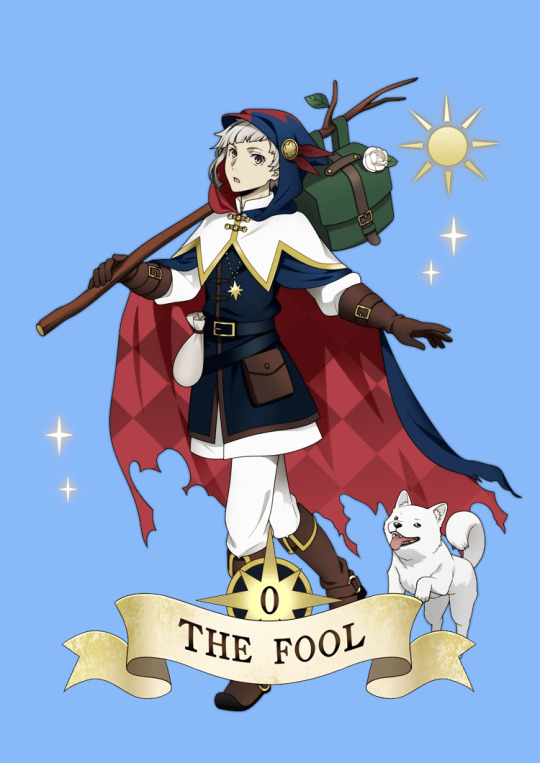
Memo:
Nakajima Atsushi as The Fool tarot card. While initially surprised by the name of his card, after learning of its interpretations, he seems to be deeply moved as he looks back on his past.
Quotes:
- “The name of this card, ‘The Fool’, surprised me at first, but I see it has positive meanings too! I'm kind of relieved...”
- “It also stands for ‘freedom’. Hm... Compared to my old self, I can learn a lot of things, everyone from the Agency is by my side... and I can decide my own path...”.
Description:
The Fool usually gazes at the sky and the universe. Atsushi’s gaze is turned towards the viewer, probably a design decision. But he has his head lifted up towards the sky, still implying the original direction of The Fool’s gaze.
He carries his bag with a branch that rests on his shoulder and the bag contains all the things that he needs. Since it’s not big, it could mean that he either doesn’t need much or that he doesn’t own much to begin with. The white rose on his bag symbolizes purity and innocence. The white dog to his feet symbolizes loyalty and protection.
Normally, The Fool is seen to be at the edge of a cliff, unaware that he could fall into the unknown. Behind him is a mountain, symbolizing the challenges that are about to come. But he doesn’t care about these things right now, he’s focused on starting his journey and to learn the lessons that he came to learn.
Meanings and Interpretations:
- UPRIGHT: (new) beginnings, freedom/free-spirited, adventure, travel, originality, innocence, foolishness, carelessness, idealism, youth, spontaneity, lack of commitment.
- REVERSED: recklessness/risk-taking, carelessness, negligence, stupidity, distraction, apathy, irrationality, lack of fun/hope/faith, holding back.
Atsushi’s reaction at the meaning of his card is not surprising, since the word “fool” is not associated with positive meanings. The Fool in tarot is interpreted as the protagonist of a story and the Major Arcana is the path he must take, which is also called “The Fool’s Journey”. Along his way he meets new teachers and new life lessons and unveils the great mysteries of life. He eventually completes his journey reaching The World card.
Despite its name, The Fool is generally a positive card and the change it brings are seen as a welcome one. It indicates new beginnings, which means that someone is on the start of an exciting and unexpected adventure. On this adventure, The Fool may take a leap of faith, but will grow through this as a result. The adventure may not only be mental, but also physical, where The Fool has to travel to a place they’ve never been before.
Reversed, The Fool still means new beginnings, but it can signify that the person is reluctant to start their adventure or to jump into their new experience. It can indicate that the person is living in the moment, but that they behave recklessly towards others in their excitement.
~ ~ ~
This fits Atsushi, since he is the protagonist of BSD’s main story and his journey starts without him knowing about all the things that are about to come (positive and negative).
Atsushi’s past experiences in the orphanage as well as his isolated upbringing make him somewhat unaware and naïve about the world he lives in and its rules. He is unsure in his own capabilities and hesitates to take a new path unfolding before him (e.g., him joining the ADA). The new beginnings, as well as the dog symbolizing loyalty and protection could be a give and take symbolization for Atsushi. Meeting several characters in his life (especially the ADA members) offers him a new beginning, but he also stands in as a new beginning for these characters.
He is loyal and protective towards people who are important to him, but they also believe in him and are loyal and protective towards him, too. During his journey he takes a leap of faith in trusting in characters that were on the antagonizing side at first (Lucy, Akutagawa, Fitzgerald) and as a result, he grows through these interactions.
If possible, he likes to avoid doing tasks alone due to his lack of self-confidence and experience, which is shown when he questions himself, feels distressed or tries to avoid tough situations. Whenever the situation forces him to rely on himself (e.g., infiltrating Moby Dick) he comes out of it having learned a new lesson. His journey doesn’t only take place in his mind, but he has also physically traveled to a place where he has never been before (e.g., Standard Island).
Negative memories and experiences are something that hold him back throughout the story and make him hesitant in his decisions (e.g., the headmaster’s voice in his mind). He acts recklessly and careless in stressful situations, which causes him to tap into other characters’ traps (e.g., when he was under Q’s curse). During these situations he is not able to move on on his own and needs the help of others (e.g., Dazai scolding him). But he slowly realizes that he is now free from those past circumstances. He embraces the good things in his life and with this gradually moves on from his past.
Yosano – The Empress

Memo:
Yosano Akiko as The Empress tarot card. While she is not particularly interested in the divination aspect of tarot, she seems to have noticed the similarities between herself and The Empress.
Quotes:
- “Tarot, yes... I am not at all interested in the overly uncertain aspects of divination, but The Empress has a rather beautiful design. I like it.”
- “Apparently, The Empress is associated with vitality. Fufu, ‘vitality’. I like the sound of that.”
- “I can only treat humans. And even then, I cannot treat all humans. I cannot control the vitality of the land like The Empress. Even so, I must do what I can.”
Description:
The Empress sits on a throne as representation of her dominion over growing things. She wields a scepter with her left hand, which represents her power over life. A shield is placed at her feet, the eagle on it is the heraldic emblem of the Holy Roman Empire. She wears a crown with stars, showing her connection to the mystical realm and the cycles of the natural world (usually there are twelve stars, symbolizing the twelve months of the year and the twelve planets).
Golden wheat grows in the foreground, framing her figure and indicating the abundance of harvest. The background is adorned with mountains, instead of a forest as in the original design. The depiction of nature in The Empress’ card signifies her connection with Mother Earth and life itself. She rejuvenates herself by the energy of nature.
The figure of The Empress is often depicted as a pregnant woman, her robe is patterned with pomegranates, the symbol of fertility. She is also mostly adorned with the symbol of Venus (that is sometimes shown on the shield instead of the eagle), which is the epitome of love, creativity, fertility, beauty and grace.
Meanings and Interpretations:
- UPRIGHT: Pregnancy, fertility, motherhood, sensuality, nurturing, creativity, beauty, femininity, nature, harmony, art, abundance.
- REVERSED: Insecurity, infertility, lack of confidence, lack of growth, overbearing tendencies, disharmony, negligence, creative block, dependence on others.
The Empress represents femininity and motherhood. Parents-to-be (mothers as well as fathers) who receive this card are encouraged to build on their communication with their children and to show them their nurturing side. However, even if the person is not a parent The Empress’ message stays the same.
It tells you to embrace your softer side and to listen to your emotions and intuition. People, especially those in need of empathy and compassion, will be drawn to you and you will be able to provide them with your nurturing. Not only does The Empress represent the creation of life, but also of romance, art or business. She symbolizes the emergence of an idea and the need to be receptive to change.
When The Empress appears reversed it tells you to embrace your feminine qualities. This also applies to men, as it is believed in tarot that all humans have masculine and feminine energies that need to be brought into balance. It signifies that a person may have been suppressing or neglecting their feminine side that needs to be embraced.
A person may be too focused on the material and mental aspects of their life and has disregarded the emotional and spiritual aspects. They may be putting the needs of others before their own or they may feel emotionally overwhelmed, so that they neglect the people important to them. It is advised to shift your focus in these situations and to ground yourself to get back to your inner balance.
~ ~ ~
Yosano is not associated with pregnancy or motherhood per se (since she is not a mother), but her role as a doctor and her ability can be interpreted symbolically in that way. She “creates” life or “gives birth” by bringing people back to life. She “nurtures” life by healing severe wounds.
This fits with her story arc, because she started her medical career already in her childhood. What began as a forced work during the war, turned out be a good blessing at first. The soldiers were in awe with her and her restoring ability, they were thankful and drawn to her nurturing side.
However, this turned out to be seen as the exact opposite, when the soldiers gradually experienced more trauma due to them being brought back to life over and over again. The same people now behaved hostile towards Yosano, involuntarily earning her the title “the angel of death”.
This trauma and abuse led to Yosano suffering herself, because she was forced to put the need of others before her own. This then led to her despising her own life and ability. She became visibly miserable and just a shell of who she once was, believing that she only brought demise to other people.
It was only when Fukuzawa and Ranpo found her that she started to gain hope and strength, because she was told that they were not interested in her ability, but in her kindness for others.This was the start for Yosano to realize that it’s not her supernatural ability alone, but also her mind and intentions that can help people, and marks the start of her career as the ADA’s doctor (even without her ability she is still a doctor and even without that she still values life and wants to save it).
Through her experiences she now knows the limits of her own abilities (both her supernatural ability and her abilities as a doctor), which can be seen in her reaction to her card. She still hasn’t given up on her work and duty, despite her negative memories. She won’t be losing track of herself, because she now has people at her side who truly care for her.
Kenji – The Chariot
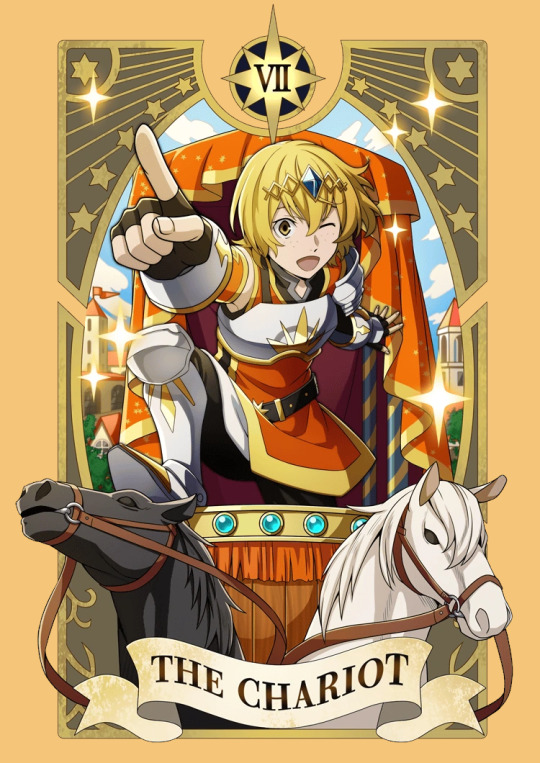
Memo:
Miyazawa Kenji as The Chariot tarot card. He seems very interested in the illustrations of the brave horses and their chariot. The two horses depicted on the card remind him of his days back in Ihatov.
Quotes:
- “The Chariot looks so valiant! And it has two horses! I bet they're good horses.”
- “Apparently, one of the meanings of The Chariot is ‘the ability to take action’. Hmm~, I can't really tell, but what do you think? Do I have that?”
- “I think it would be so fun if I could do my detective work with horses like the boy on this card! If I worked with horses, I feel like I'd be able to do a lot more!”
Description:
Kenji is depicted as armored warrior. His laurel crown (although heavily altered in design) symbolize victory, success and spiritual evolution. The figure of The Chariot usually stands tall inside his chariot. In Kenji’s case that has been upgraded and exaggerated to him standing with one foot on the foreside and pointing with one finger ahead. A heavy indication of taking action and moving forward.
In front of the chariot are two horses, which represent positive and negative opposing forces and duality. The two horses pull in different and opposing directions, yet The Chariot uses his willpower and sheer resolve to move them in the direction that he wants. He doesn’t need to hold reins to move, instead he controls it through the strength of his will and mind.
In the original card’s design, the armor of The Chariot is decorated with crescent moons, which represent what is coming into being, a tunic with a square, representing the strength of will and other alchemical symbols that are a representation of spiritual transformation.
The canopy above his head is adorned with six pointed stars that indicate his connection to the celestial world and the divine will. Instead of horses, two sphinxes are in the foreground. A city with a large river can be seen behind The Chariot, symbolizing the need to be in flow with the rhythm of life while charging ahead towards your goals.
Meanings and Interpretations:
- UPRIGHT: victory, overcoming obstacles, success, ambition, determination/willpower, control, self-discipline, hard work and focus, action.
- REVERSED: forcefulness, lack of direction, lack of self-control, powerlessness, aggression, coercion, being blocked by obstacles, opposition.
The Chariot upright represents overcoming obstacles through determination, focus and willpower. The person may feel motivated, ambitious and in control, therefore they are encouraged to go for what they want. There may be challenges and obstacles in The Chariot’s path, but if you stay focused and believe in your own abilities, you will be able to overcome these. The Chariot can also represent travel, as it is a means of transportation.
People who receive this card may feel like they are fighting a battle and because of that act defensively or aggressively to hide that they are emotionally vulnerable at the moment. In this case, you are encouraged to find balance between the heart and the mind. The Chariot also indicates success in sports and competitions.
The Chariot reversed means that a person may feel powerless and lack direction and confidence. They may feel put upon by others or the circumstances in their life. This can lead to anger and frustration as well as uncontrolled aggression. The Chariot advises you that you need to take control of your own destiny and to not let outside forces determine your path.
It indicates that you need to set boundaries and stick to them and to be clear about the time and resources you are willing to dedicate to others. If people in your life become too needy and demanding the person is advised to take back their own power.
~ ~ ~
Kenji starts his story by moving from the land to the city. His decision to leave his family and village, live in the city and to work for the ADA can be interpreted as him moving forward in a physical and spiritual sense. He is willing to challenge his new surroundings and grows through this as a result.
He has shown to be very confident in himself and his abilities, being the most optimistic of the group and to always look on the positive side of things. Tough situations do not worry him much, because he believes the outcome will work out just fine.This determination also transfers to other characters when they are with him and should they find themselves in a distressed situation (e.g., when he had his mission with Atsushi who was constantly worried about how Kenji does his work).
Being able to control something with his pure willpower could also be interpreted as an allusion to his supernatural ability that allows him to lift up cars or tear down stone walls on a whim. However, Kenji’s ability relies on the fact that he needs to be hungry in order to use it and the ADA members also advise to not disturb him when he is sleeping, because he will get irritated and aggressive in that state.
Kenji has been shown to not only be able to get over physical obstacles, thanks to his ability (e.g., bringing Fukuzawa out of the hospital). He is also able to encourage his peers to get over mental obstacles (e.g., his speech to the ADA when they flee from the HD).
Kunikida – Justice

Memo:
Kunikida Doppo as the Justice tarot card. Having always stood for justice and ideals, Kunikida has a favorable impression of this card.
Quotes:
- “Justice... What a well-named card. The sword and scale illustrations aren't bad either.”
- “I have no desire to sit on a throne, but I value fairness, which is one of the meanings this card holds. I want to uphold this as I carry out my Agency duties.”
Description:
Kunikida as the figure of Justice sits on a throne, holding a sword in his right hand and scales in his left hand. The sword points upwards, symbolizing a firm and final decision. Its double-edged blade is a reminder that our actions always carry consequences. The scales show that intuition must always balance logic and are a symbol of impartiality.
He wears a crown with a small square on it, a representation of well-ordered thoughts. His white shoes looking from underneath his robe also symbolize that our actions have spiritual consequences.
The figure of Justice sometimes is depicted in front of a loosely hung purple veil, which signifies compassion. Two pillars frame the figure, symbolizing balance, law and structure.
Meanings and Interpretations:
- UPRIGHT: justice, karmic justice, consequences, legal disputes, law, truth, honesty, integrity, cause and effect, life lessons, fairness.
- REVERSED: injustice, karmic retribution, dishonesty, corruption, lack of accountability, dishonesty, unfairness, karmic avoidance.
In an upright context, the Justice tarot card is a representation of karmic justice, legal matters, cause and effect. Justice symbolizes truth and integrity and can imply that a person may feel the urge to speak out the truth. This person values honesty and integrity in others, too.
Justice also relates to balance and signifies that an event may occur that is beyond a person’s control or their own making. In these moments Justice encourages the person to keep themself level-headed as the events unfold. It also signifies that a person is about to make a choice and that they are currently weighing all their options. In legal matters, this card shows that the outcome will be a fair and balanced result.
Reversed, Justice means injustice and the avoidance of karmic justice. It symbolizes that a person has been treated unjustly or that they are in a situation where they are being affected unfairly by the choices and actions of others. The person may feel victimized or blamed for something that isn’t their fault. Justice reminds the person to still keep their balance. If the person created the situation themself, it is advised to think about how they can react to that situation. It also signifies that the person must be accountable, if they created the situation by bad choices and actions. This means that the person should not blame others and to be more self-aware.
It can also symbolize dishonesty and that a person should not lie their way out of something or try to justify it. The person may also have hardline views in their life and prejudices the people around them. In legal matters, Justice indicates that the result will be one of injustice or that the outcome may not what the person has hoped for.
~ ~ ~
Kunikida is practically the personification of justice of all of the ADA members and justice is also something that he has been shown to think about a lot. He takes his work very professional and serious and tries to bring every case to a fair result. If he isn’t able to save people, he calls out the unfairness of the situation (e.g. when he tried to save the abducted victims in the Azure Messenger case.) This shows that he feels responsible and guilty even for events that were out of his control.
He seems to try to balance his own life by sticking to his written ideals and calls others out shouldn’t they behave in the same way (e.g. mostly seen when Dazai is neglecting his work). If he notices that people are distressed during a bad situation, he reminds them to keep their balance or he tells them to think about what they can do (e.g. to Atsushi when the Black Lizard attacked the ADA office). But he also reminds himself about these things (e.g., seen when he was told by Jouno that he felt relieved about the ADA getting caught and with this his ideals falling apart. But then he got back to his knees and defended the ADA, so that they could escape.)
When Kunikida meets new people, he keeps up his guard and distance at first, and holds prejudices about them (e.g. when he met Dazai, Atsushi and Kyouka). This can lead to him having a wrong first impression of people (negative and positive) and with this easily fall into traps (e.g., when he did not realize that Sasaki was the Azure Messenger).
This implies that he first weighs to be careful about whom he trusts (in this case a new colleague), and changes his mind about them later, once they have proven to be trustworthy.
Tanizaki – Temperance

Memo:
Tanizaki Junichiro as the Temperance tarot card. While he initially tilted his head at the card's rather strange design, he faces its mystical aura head-on. He seems to have interpreted the card's meaning in his own way.
Quotes:
- “The person on this card is pouring liquid from one cup into another... What on earth for?”
- “So, Temperance also means ‘harmony’. Hm, am I harmonic? Oh, sometimes I sort things out when there's a commotion at the office... so I guess I am?”
- “Hmm, so it means ‘devotion’ too... The only person I'm devoted to is Naomi. To me, Naomi is irreplaceable.”
Description:
Tanizaki balances himself with one foot on land, representing the need to stay grounded and the other in the water, representing the need to be in flow. The water he pours between two cups are the symbol of the flow and alchemy of life. This was a standard symbol of Temperance as one of the cardinal virtues, as it represents the dilution of wine with water.
In many decks, the figure of Temperance is depicted as winged angel, but instead we see two feathers, probably meant as surrogate of the angel’s wings. The background shows a path leading to a mountain with a golden crown on top, but this depiction has been changed in Tanizaki’s card and the golden crown rests upon his own head instead. The crown is a symbol of taking the higher path and staying true to one’s meaning and purpose in life.
Meanings and Interpretations:
- UPRIGHT: Balance, peace, patience, moderation, inner calm, perspective, tranquility, harmonious relationships, soulmates, purpose.
- REVERSED: Imbalance, self-indulgence, excess, clashing, lack of perspective, discord, antagonism, recklessness, hastiness, self-healing, re-alignment.
Upright, Temperance indicates that a person has found their inner calm and peace. They have a good perspective on things and care about harmonious relationships. It signifies feeling content and having found tranquility. Temperance shows that a person is in touch with who they are inside and what they value.
They have their own moral compass and have learned not to get dragged into other people’s conflicts. Minor issues won’t knock them off balance, instead they adapt to the situation with a clear mind and a calm heart. Figuring out your aspirations and your goals is easier for people who get this card in their readings.
In a reversed position, Temperance means imbalance. It signifies that a person behaves in a reckless manner. The person may have lost touch with their inner calm and peace, which leads to them seeking gratification in harmful and risky ways (like alcohol, drug use or gambling).
It can also mean that the person has a lack of harmony with the people in their life and due to this the person may lash out to people close to them, which then causes them to get dragged into drama. In these situations, it is advised to take a step back and look at how you are behaving, because you may lack to see the bigger picture. Examining the root causes and working to resolve them is the way back to your inner calm and peace.
~ ~ ~
Tanizaki appears to be one of the calmest people in the ADA. He does not get into quarrels with others, even if he is wary or hesitant about their ideas (e.g., giving in to Naomi’s demands and shenanigans, hesitating and getting tricked by Dazai to participate in Atsushi’s entrance exam).
Although, he is nervous on missions, he still takes them on with a clear mind and a professional approach. Many missions are entrusted to him alone, showing that people know that he can handle the situation just well.
His decision to work for the ADA could imply that he has found his goal and his purpose in life. His dedication to Naomi shows that he is patient and calm, and that he cares deeply for a harmonious relationship between them. Keeping her safe above all things indicates that he’s sees it as his purpose in his life, too.
However, Naomi is also his biggest weak point. Whenever she is in danger or hurt, Tanizaki gets knocked off his balance and inner calm. These situations make him hastily jump into actions and due to this he becomes an easy target for others (e.g., when he attacked Higuchi out of anger, he didn’t notice Akutagawa; when he was about to kill Mori to save Fukuzawa, he tapped into Kouyou’s trap).
Even though this does not only concern Naomi’s well-being, as he has also been shown to make rush conclusions, if other people he cares about are in danger or in a predicament (e.g., when Fukuzawa was about to die due to cannibalism; offering to join PM as exchange instead of Yosano). His work as a detective on this aspect lets him also get regularly dragged into other people’s drama, either the drama of clients or the drama of other ADA members.
~ ~ ~ ~ ~
Sources: www.biddytarot.com | www.thetarotguide.com | https://en.wikipedia.org/wiki/Major_Arcana
#atsushi nakajima bsd#akiko yosano bsd#kenji miyazawa bsd#doppo kunikida bsd#junichiro tanizaki bsd#Atsushi Nakajima#Akiko Yosano#Kenji Miyazawa#Doppo Kunikida#Junichiro Tanizaki#bsd meta#bsd analysis#Bungou Stray Dogs#bsd mayoi
260 notes
·
View notes
Text
The Contendings of History and Seth

Seth as a serpent-slayer (MET)
It's safe to say that the myth of Osiris is one of the only non-Greek myths to enjoy a comparable degree of recognition in modern popculture. There are few direct adaptations, sure, but the core narrative is well known, and as a result works themed after ancient Egypt use Seth as a villain almost without fail if only the premise allows the use of fantastical elements.
However, in this article I will instead examine the other side of Seth, and especially his role as a protagonist of myths in his own right, including the historical circumstances of this development. While I mostly want to introduce you to a little known but fascinating world of heroic(?) portrayals of Seth, naturally I will also cover Seth's later loss of relevance and complete vilification to explain why it survived as the dominant tradition.
Early history of Seth
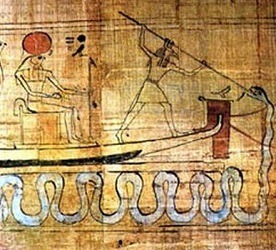
Seth protecting Ra from Apep (wikimedia commons)
From the dawn of recorded history Seth's status in Egyptian religion was ambivalent, and it continues to be a topic of heated debate among researchers what degree of popularity he enjoyed in particular very early on.
Some aspects of Seth character, like his evident interest in both men and women and whether it reflects broader Egyptian cultural norms (or if it’s merely yet another way in which Seth was an outsider among gods and men, as the author of the first monograph dealing with Seth proposed in the 1960s) are likewise a hotly debated topic.
Seth was associated with many animals, such as the hippopotamus and the crocodile, but his main symbol is the sha or “Seth animal” which is regarded as either a mystery or a fictional creation, and in Egyptian texts inhabits zones inhospitable to humans.
Seth was called “the god of confusion” by Herman Te Velde (the first writer to dedicate a monograph to him) and while this opinion has been since called into question, it is undeniable that it’s hard to form a coherent image of him.
In addition to various versions of the well known myth mentioned above there are other instances of combat between Seth and Horus (most likely initially a distinct myth combined with the narrative about Osiris’ death and resurrection at a later date) and of Seth as a menace to the established order. Some of the Pyramid Texts present even the human followers of Seth as enemies to be conquered (which is held by some researchers a mythical memory of strife between local kings before the unification of Egypt). .
However, there are also texts where Seth is a rightful member of the Ennead; where he and Horus act in harmony as protectors of the ruler; where he assists pharaohs in their resurrection in the afterlife; and even to Seth as one of the gods responsible for returning Osiris to life. A recurring motif in texts dealing with the afterlife in particular is a description of Seth offering a ladder to the dead who can reach some destination themselves. Mentuhotep II of the XI dynasty seemingly had Seth and Hathor depicted behind his throne in art; Hatshepsut described Seth positively as well.
Personal names invoking Seth are known, too; and as established by Willam Berg in his studies of a different ambivalent deity, “children are not called after spooks.”
Seth's ambiguous character made him ideal to represent The Other in Egyptian culture – the foreigners, especially these arriving from the Levant, their culture, and generally “un-Egyptian” traits. In that capacity, he functioned as an “ambassador” or “minister of foreign affairs,” to put it in modern terms. Or perhaps a foreigner in his own country, so to speak.
As a result, he came to be associated with a group of deities which, while part of the official pantheon, had their origin outside Egypt.
The Ramessides and foreign gods
Generally speaking, there were two primary sources for foreign deities incorporated into Egyptian religion: Levantine trade centers like Gebal (Byblos in Lebanon) or Ugarit (Ras Shamra in Syria); and Egypt's vassal/enemy/ally/very occasional ruler Nubia (roughly corresponding to present day Sudan).
Libyan influence was smaller, and to my knowledge there is no evidence of any major impact of Egypt's other trading partners (Punt, located near Horn of Africa, and Minoan Crete; the latter absorbed many Egyptian influences instead, though) or enemies (like the Hittites) on religion. The peculiar history of Seth is related to the the first of these areas.
Early researchers saw the “Syrian” deities as worshiped at best by slaves or mercenaries – they didn't fit neatly into the image of Egypt presented by some royal inscriptions: an unmovable, unchanging and homogeneous country, a vision as appealing to absolute rulers in the bronze age as it was to many 19th and 20th century researchers.
However, the truth was much more complex, and in fact some of the best preserved accounts of foreign cults in Egypt indicate that the process was in no small part related to the pharaohs themselves. For example Ramses II in particular was an enthusiast of Anat, as evidenced by statues he left behind:
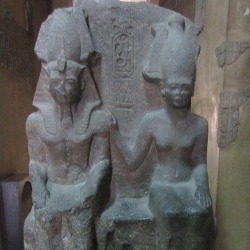
Ramses II and Anat (wikimedia commons)
He also named his daughter Bint-Anat (“daughter of Anat”) and his favorite pets and possessions bore Anat-derived names too.
Not only only Ramses II himself, but the entire XIXth dynasty – the “Ramessides” (a term also applied to the XXth dynasty) - was particularly keen on these imported deities. Curiously, one of its founders was named Seti - “man of Seth,” and Seth was seemingly the tutelary deity of his family. The well known case of Ramses II's red hair might be connected to this – this uncommon trait was associated with Seth.
As a result of the Ramessides' rise to power Seth became one of the state gods in Egypt, alongside heavyweights like Amun, Ptah or Ra. However, it's also safe to say that he was popular in everyday cult among commoners, as evidenced by finds from camps for workers partaking in various construction projects.
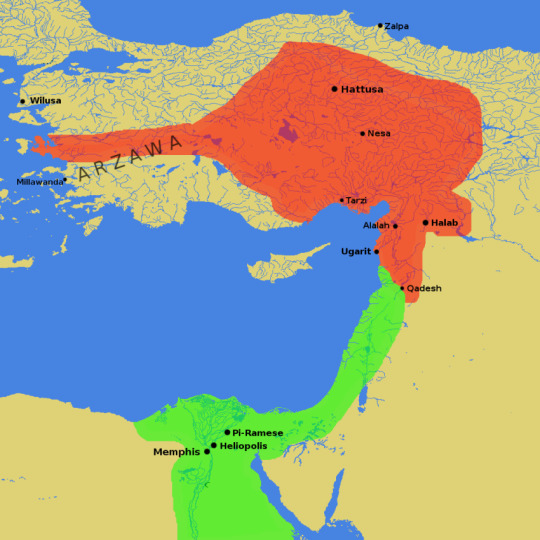
Part of Egypt of the Ramessides at its maximal extent (in green; wikimedia commons)
During the discussed period, Egypt was as the peak of its power, both military and cultural; the “other” recognized Egypt's power. Weaker states in the proximity of Egypt paid tribute, while the more distant fellow “superpowers”of the era (the Hittites and the Mitanni, rivals of Egypt in Syria and the Levant, and the more distant Kassite Babylon) bargained with Egypt for dynastic marriages, luxury goods or craftsmen. While some foreign rulers didn't necessarily get that the pharaohs might not want to play by their rules and expressed frustration with that in their letters sometimes (see a particularly funny example below), overall the relations were positive, and resulted in a lot of interchange between cultures.

(source)
The incorporation of foreign deities into Egyptian pantheon was a phenomenon distinct both from the well known practice of interpretatio graeca and from the monumental Mesopotamian god lists, and foreign gods were adopted rather selectively. Some researchers propose that the incorporated deities were often chosen because their sphere of influence wasn't covered by any native god.
For example, Astarte (more accurately Ashtart or Athtart, considering the Ugaritic orthography; however the Greek spelling is used in literature to refer to the Egyptian version and I'll stick to that) was associated with horses and chariot warfare. As the animal wasn't known in Egypt in the formative period of the state, it wasn't among the symbols of any local deity; at the same time chariots were a prominent component of the Egyptian military at the height of its power, and as such required a deity to be put in charge of it.
Six deities of broadly “Syrian” origin are usually listed among Egyptian gods in modern scholarly literature: Anat, Astarte, Resheph, Houron, Baal (the Ugaritic weather controlling one) and Qadesh. Of these, four were pretty similar to their original versions. Qadesh is a complex case as it's uncertain if such a deity existed outside Egypt – it's possible she developed as a combination of a divine title (“the holy one”) and the general Egyptian perception of foreign religion. Some scholars in the past asserted she is simply Athirat/Asherah but this interpretation relied on the false premise of Athirat forming a trinity with Anat and Ashtart and the three of them being the only prominent goddesses in cities like Ugarit.
There are also curiosities like Chaitau, a god with Egyptian name (“he who appears burning”) but attested only in sources from Levantine cities (though ones written in hieroglyphics) and in magical formulas of similar origin.
Baal is the most puzzling case: simply put, it's clear Baal was introduced to Egypt. It's clear Baal was depicted in Egyptian art. It's even clear that Egyptians knew that Anat and Astarte were deities from Baal's circle back at home, and that Baal was tied to a narrative about combat with the sea. And yet, it's not easy to say where the Egyptian reception of Baal ends and where Seth starts. Baal's name was even written with the Seth animal symbol as determinative. When exactly did this identification first occur is unknown: while it would be sensible to assume the Hyksos, a Canaanite group which settled in Egypt and briefly ruled the Nile delta, are responsible, there is some evidence which might indicate this already happened before.
Baal and Seth
Baal was a natural match for Seth: Seth represented the foreigners, Baal was the most popular god of the foreign group most keen on settling in Egypt; Baal has a somewhat unruly character in myths; both rule over storms and have a pronounced warrior character. Additionally, both of them were depicted as enemies of monstrous serpents.
Baal was identified with Seth in Egypt, but in turn Seth became more Baal-like too. So-called “Stela of year 400” depicts an entity labeled as Seth more similar in appearance to Baal due to the human face and Levantine, rather than Egyptian, garb:
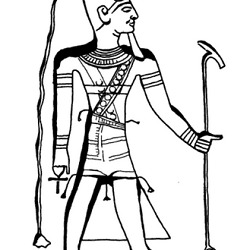
(source)
It is well known that the main myth of Baal, in Ugarit the first part of the “Baal cycle,”describes his combat with the sea, personified by the god Yam, seemingly described both as humanoid and serpentine. In Egypt, this narrative was associated with the composite Seth-Baal, and a fragmentary version is recorded in the so-called Astarte papyrus. Curiously, it was actually discovered long before the Baal cycle itself – however, it only became a subject of in depth studies in the wake of the discovery of Ugarit. There are also many similarities to the Hurrian myth “Song of the Sea,” known only from fragments, and to the Song of Hedammu from Hittite archives.
While in the Ugaritic version Baal fought the personified Sea against the wishes of the head god El, in the Egyptian version the confrontation happens because the Ennead fears Yam, who threatens to flood the earth and demands tribute, much like the Hurrian Sea.
Before Seth properly enters the scene, we learn about how Ptah and Renenutet, a harvest goddess, appeal to his associate Astarte (as already noted before viewed as Ptah's daughter in Egypt), hoping she'll act as a tribute bearer. Astarte is described as a fearsome warrior; however, she is not meant to fight Yam herself, but merely temporarily placate him. She seemingly strips down and brings offerings – this is, once again, closer to the Hurrian than Ugaritic version, where Shaushka, an “Ishtar type” goddess like Astarte, seduces the sea monster Hedammu in a similar way. It is not clear if Yam is interested, though - in fact he appears to question why Astarte isn’t dressed (possibly mocking what must’ve been a humiliating situation for a warrior deity, I’d assume).
Eventually, Seth arrives and presumably fights Yam, likely with Astarte's help - the rest of the papyrus is too poorly preserved to decipher, but as indicated by the foreign equivalents Seth and Astarte win. This is confirmed by the Hearst Medical Papyrus, imploring Seth to expel illness from the treated person just like he vanquished the personified Sea.
The Ugaritic version of the myth doesn’t include a tribute scene among surviving fragments, though it’s worth pointing out that the Ugaritic Ashtart/Astarte cheers on Baal during his battle against Yam and berates him for not acting quick enough, which is easy to interpret as hostility caused by a similar episode. Many researches assume that it existed among the lost fragments of the Baal Cycle tablets, though this is for now purely speculative.
A variant of the myth of Seth and Horus - The Contendings of Horus and Seth - presents a further curious case of Seth-Baal syncretism, this time incorporated into well established Egyptian myth rather than an imported foreign one.
Seth and Horus compete for the right to rule after Osiris' death. Ra thinks Seth is the better option to nominate as a successor because Seth killed Apophis on his behalf, but a few other of the elder gods disagree and try to delay the process by insisting to ask various deities to provide their expert opinions.
These generally favor Horus much to Ra's annoyance, but he can't go against them so he insults Horus (calling him "feeble and weak-limbed" and criticizing his hygiene) but doesn't stop his rise to power. The semi-humorous portrayal of Ra is rather unusual; in addition to showing annoyance with other gods, at one point he vanishes, and only agrees to return because Hathor lured him out.
It seems Horus' mother Isis insults Seth in response to Ra's comments. Seth, offended, refuses to partake in the divine assembly unless Isis leaves; Ra orders that and the gods gather again without her. However, Isis disguises herself and asks Seth who should inherit first, a child or a brother who can provide for himself (and is a foreigner), to which Seth replies that the former; this was a trick, obviously, and Isis holds it as proof that Seth forfeited his right to rule, which Ra accepts.
After multiple chaotic tribulations (including the [in]famous lettuce episode as well as Horus decapitating his mother because he decides she doesn't do enough) Horus is re-declared king but Ra, implored by Ptah (otherwise absent from the myth) gives Seth two wives (eg. Anat and Astarte; this solution was suggested already earlier by the gods providing the opinion; some authors question if they are meant to be Seth’s wives or merely allies, much like the relationship between Baal, Anat and Ashtart in Ugarit is considered debatable) and the storm clouds as his new domain. He is to strike fear into hearts of men, but will also get to be treated as if he were Ra's own son.
Considering the emphasis on storm and the mention of Anat and Astarte, it's pretty clear to me that Egyptians essentially invented their own Baal backstory meant to integrate the foreign tradition with their own by recasting Baal and Seth as the same entity. The text is however unusual because of its humorous tone – the gods insult each other, act ineptly and all around hardly provide an inspiring example. Perhaps the focus on Seth made this possible.
As a final note before I'll move on to times much less prosperous for Seth it's worth to mention that not only Baal but also other foreign gods were at times equated with Seth. The Libyan god Ash was conflated with him in the western oases, while treaties with the Hittites assign the name of Seth to various members of their pantheon, including the Baal-like Tarhunna (equivalent of Hurrian Teshub) but also the sun goddess of Arinna.
Demonization of Seth
While in the late bronze age Seth greatly benefited from his role as a god of foreigners, in later periods this has proven to be his undoing.
Egypt couldn't maintain its power forever, and eventually fell to the Assyrians, who showed little respect for local culture and looted Thebes. While the Assyrian domination was only temporary, it severely damaged the country, and a spiritual scapegoat was needed to reconcile the carnage with the idea that Egypt was a land chosen and protected by the gods.
The change seemingly occurred under the rule of Psamtik – in a new version of the myth of Seth and Horus, Seth not only lost decisively, but also was punished afterwards, and religious texts spoke of a “rebellion”of Seth. Seth was never associated with Ashur, the head god of the Assyrians, before, but in Egyptian imagination he was blamed for bringing the invaders under “his” command to ravage and subjugate the country. A mythical text has Isis implore Ra to punish Seth for robbing temples, much like the Assyrian armies did. Even later accounts tell various tales about Seth being punished, either gruesomely (a few texts recount massacred of towns belonging to Seth) or humorously (for example in one text Thoth makes him impotent with a spell) and exiled from among gods.
There's evidence that the worship of Seth, previously commonplace, came to be abhorred and depictions of Seth were destroyed or altered. A famous example is a Seth statue converted to look like Knhnum or Amun instead:
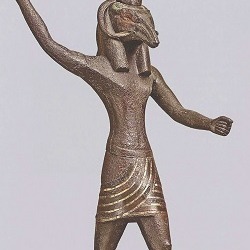
Seth no more (wikimedia commons)
A late relief from Edfu, from the Ptolemaic times, seems to indicate that even Seth's role as a guardian of the solar barge was lost: Seth, depicted as a hippopotamus, was defeated by Horus from the solar barge of Re. However, while Apep is usually depicted as huge and menacing, hippo Seth is tiny and pathetic.
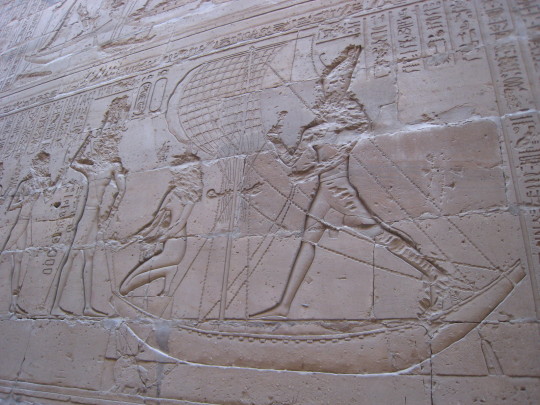
Seth as a tiny hippo representing the forces of chaos (wikimedia commons)
Curiously, despite the official policies, which continued under Ptolemaic rule, it seems that until the 2nd century CE, Seth continued to be popular in the Dahkleh oasis, possibly even serving as the main deity there. Sadly due to lack of research I am unable to provide any more detailed information about that.
Closing remarks
Even further demonization of Seth is evident in the fact that the Greeks and Romans referred to Seth as Typhon, leaving no room for ambiguity of interpretation. As the Greek accounts of the late version of Seth were all that was known for centuries due to ability to read hieroglyphic writing vanishing with the advent of new religions, it remains dominant in media today.
Perhaps it would be beneficial to leave some room for the serpent-slaying hero Seth hanging out with foreign deities in modern works, though? Surely his peculiar outsider status is even more appealing to modern readers than it was to the public of the Ramesside period.
Bibliography
N. Ayali-Darshan, The Other Version of the Story of the Storm-god’s Combat with the Sea in the Light of Egyptian, Ugaritic, and Hurro-Hittite Texts
G. Beckman, Foreigners in the Ancient Near East
M. Dijkstra, Ishtar seduces the Sea-serpent. A New Join in the Epic of Hedammu (KUB 36, 56+95) and its meaning for the battle between Baal and Yam in Ugaritic Tradition
T. J. Lewis, ʿAthtartu’s Incantations and the Use of Divine Names as Weapons
D. Schorsch and M. T. Wypyski, Seth, "Figure of Mystery"
D. T. Sugimoto (ed.), Transformation of a Goddess. Ishtar – Astarte – Aphrodite - especially the chapters ‘Athtart in Late Bronze Age Syrian Texts by M. S. Smith and Astarte in New Kingdom Egypt: Reconsideration of Her Role and Function by K. Tazawa
H. Te Velde, Seth, God of Confusion: A Study of His Role in Egyptian Mythology and Religion
P. J. Turner, Seth - a misrepresented god in the Ancient Egyptian pantheon? (PhD thesis)
C. Zivie-Coche, Foreign Deities in Egypt
110 notes
·
View notes
Photo
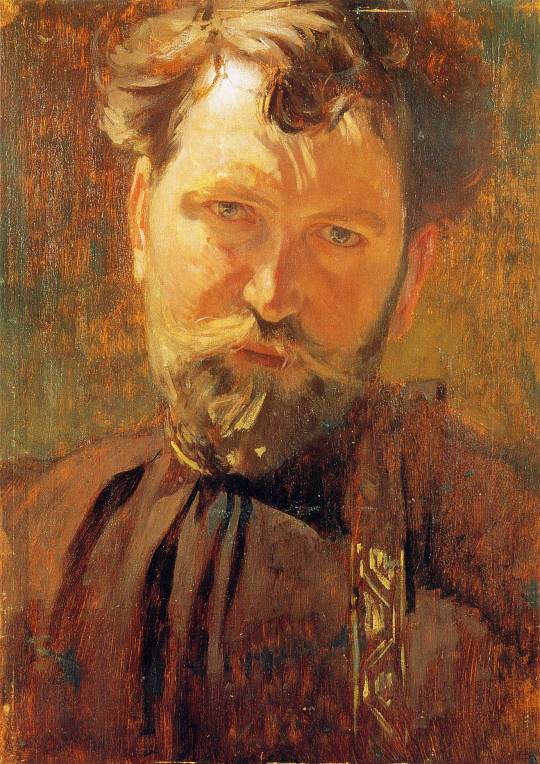
Self-Portrait by Alphonse Mucha, 1899
Alfons Maria Mucha (Czech: 24 July 1860 – 14 July 1939), known internationally as Alphonse Mucha, was a Czech painter, illustrator, and graphic artist, living in Paris during the Art Nouveau period, best known for his distinctly stylized and decorative theatrical posters, particularly those of Sarah Bernhardt. He produced illustrations, advertisements, decorative panels, and designs, which became among the best-known images of the period.
In the second part of his career, at the age of 43, he returned to his homeland of Bohemia-Moravia region in Austria and devoted himself to painting a series of twenty monumental canvases known as The Slav Epic, depicting the history of all the Slavic peoples of the world, which he painted between 1912 and 1926. In 1928, on the 10th anniversary of the independence of Czechoslovakia, he presented the series to the Czech nation. He considered it his most important work. It is now on display in Prague.
Alphonse Mucha was born on 24 July 1860 in the small town of Ivančice in southern Moravia, then a province of the Austrian Empire (currently a region of the Czech Republic). His family had a very modest income; his father Ondřej was a court usher, and his mother Amálie was a miller's daughter. Ondřej had six children, all with names starting with A. Alphonse was his first child with Amálie, followed by Anna and Anděla.
Alphonse showed an early talent for drawing; a local merchant impressed by his work provided him with paper for free, though it was considered a luxury. In the preschool period, he drew exclusively with his left hand. He also had a talent for music: he was an alto singer and violin player
After completing volksschule, he wanted to continue with his studies, but his family was not able to fund them, as they were already funding the studies of his three step-siblings] His music teacher sent him to Pavel Křížkovský, choirmaster of St Thomas's Abbey in Brno, to be admitted to the choir and to have his studies funded by the monastery. Křížovský was impressed by his talent, but he was not able to admit and fund him, as he had just admitted another talented young musician, Leoš Janáček.
Křížovský sent him to a choirmaster of the Cathedral of St. Peter and Paul, who admitted him as a chorister and funded his studies at the gymnasium in Brno, where he received his secondary school education. After his voice broke, he gave up his chorister position, but played as a violinist during masses.
He became devoutly religious, and wrote later, "For me, the notions of painting, going to church, and music are so closely knit that often I cannot decide whether I like church for its music, or music for its place in the mystery which it accompanies." He grew up in an environment of intense Czech nationalism in all the arts, from music to literature and painting. He designed flyers and posters for patriotic rallies.
His singing abilities allowed him to continue his musical education at the Gymnázium Brno in the Moravian capital of Brno, but his true ambition was to become an artist. He found some employment designing theatrical scenery and other decorations. In 1878 he applied without success to the Academy of Fine Arts in Prague, but was rejected and advised to "find a different career". In 1880, at the age of 19, he traveled to Vienna, the political and cultural capital of the Empire, and found employment as an apprentice scenery painter for a company which made sets for Vienna theaters. While in Vienna, he discovered the museums, churches, palaces and especially theaters, for which he received free tickets from his employer. He also discovered Hans Makart, a very prominent academic painter, who created murals for many of the palaces and government buildings in Vienna, and was a master of portraits and historical paintings in grand format. His style turned Mucha in that artistic direction and influenced his later work. He also began experimenting with photography, which became an important tool in his later work.
To his misfortune, a terrible fire in 1881 destroyed the Ringtheater, the major client of his firm. Later in 1881, almost without funds, he took a train as far north as his money would take him. He arrived in Mikulov in southern Moravia, and began making portraits, decorative art and lettering for tombstones. His work was appreciated, and he was commissioned by Count Eduard Khuen Belasi, a local landlord and nobleman, to paint a series of murals for his residence at Emmahof Castle, and then at his ancestral home in the Tyrol, Gandegg Castle. The paintings at Emmahof were destroyed by fire in 1948, but his early versions in small format exist (now on display at the museum in Brno). He showed his skill at mythological themes, the female form, and lush vegetal decoration. Belasi, who was also an amateur painter, took Mucha on expeditions to see art in Venice, Florence and Milan, and introduced him to many artists, including the famous Bavarian romantic painter, Wilhelm Kray, who lived in Munich.
Count Belasi decided to bring Mucha to Munich for formal training, and paid his tuition fees and living expenses at the Munich Academy of Fine Arts. He moved there in September 1885. It is not clear how Mucha actually studied at the Munich Academy; there is no record of his being enrolled as a student there. However, he did become friends with a number of notable Slavic artists there, including the Czechs Karel Vítězslav Mašek and Ludek Marold and the Russian Leonid Pasternak, father of the famous poet and novelist Boris Pasternak. He founded a Czech students' club, and contributed political illustrations to nationalist publications in Prague. In 1886 he received a notable commission for a painting of the Czech patron saints Cyril and Methodius, from a group of Czech emigrants, including some of his relatives, who had founded a Roman Catholic church in the town of Pisek, North Dakota. He was very happy with the artistic environment of Munich: he wrote to friends, "Here I am in my new element, painting. I cross all sorts of currents, but without effort, and even with joy. Here, for the first time, I can find the objectives to reach which used to seem inaccessible." However, he found he could not remain forever in Munich; the Bavarian authorities imposed increasing restrictions upon foreign students and residents. Count Belasi suggested that he travel either to Rome or to Paris. With Belasi's financial support, he decided in 1887 to move to Paris.
Mucha moved to Paris in 1888 where he enrolled in the Académie Julian[18] and the following year, 1889, Académie Colarossi. The two schools taught a wide variety of different styles. His first professors at the Academie Julien were Jules Lefebvre who specialized in female nudes and allegorical paintings, and Jean-Paul Laurens, whose specialties were historical and religious paintings in a realistic and dramatic style. At the end of 1889, as he approached the age of thirty, his patron, Count Belasi, decided that Mucha had received enough education and ended his subsidies.
When he arrived in Paris, Mucha found shelter with the help of the large Slavic community. He lived in a boarding house called the Crémerie at 13 rue de la Grande Chaumière, whose owner, Charlotte Caron, was famous for sheltering struggling artists; when needed she accepted paintings or drawings in place of rent. Mucha decided to follow the path of another Czech painter he knew from Munich, Ludek Marold, who had made a successful career as an illustrator for magazines. In 1890 and 1891, he began providing illustrations for the weekly magazine La Vie populaire, which published novels in weekly segments. His illustration for a novel by Guy de Maupassant, called The Useless Beauty, was on the cover of 22 May 1890 edition. He also made illustrations for Le Petit Français Illustré, which published stories for young people in both magazine and book form. For this magazine he provided dramatic scenes of battles and other historic events, including a cover illustration of a scene from the Franco-Prussian War which was on 23 January 1892 edition.
His illustrations began to give him a regular income. He was able to buy a harmonium to continue his musical interests, and his first camera, which used glass-plate negatives. He took pictures of himself and his friends, and also regularly used it to compose his drawings. He became friends with Paul Gauguin, and shared a studio with him for a time when Gauguin returned from Tahiti in the summer of 1893. In late autumn 1894 he also became friends with the playwright August Strindberg, with whom he had a common interest in philosophy and mysticism.
His magazine illustrations led to book illustration; he was commissioned to provide illustrations for Scenes and Episodes of German History by historian Charles Seignobos. Four of his illustrations, including one depicting the death of Frederic Barbarossa, were chosen for display at the 1894 Paris Salon of Artists. He received a medal of honor, his first official recognition.
Mucha added another important client in the early 1890s; the Central Library of Fine Arts, which specialized in the publication of books about art, architecture and the decorative arts. It later launched a new magazine in 1897 called Art et Decoration, which played an early and important role in publicizing the Art Nouveau style. He continued to publish illustrations for his other clients, including illustrating a children's book of poetry by Eugène Manuel, and illustrations for a magazine of the theater arts, called La Costume au théâtre.
44 notes
·
View notes
Text
An analysis of Iori and his character arc

Iori has a particularly interesting position in 02′s narrative (and, even more widely so, in perhaps all of both Adventure and 02) in that his base profile is rather unusual-looking even from the get-go -- the youngest child in both groups, yet with a (seemingly) mature demeanor that surpasses even his seniors. On top of that, Iori ends up having a very deep relation to 02′s themes and plot itself in a way that isn’t initially apparent, but actually makes him a very vital centerpiece of 02′s story.

Before we get into Iori’s role in 02′s actual plot, it needs to be established that a very, very large amount of Iori’s character is heavily shaped by his family background and upbringing. Prior to the start of the series, the Hida family had a large void in it, with Iori’s father Hiroki having been killed in the line of duty. Being a mere five-year-old child who had lost his father barely into actually being sentient and basically had to live the following three years going off hearsay on what he was actually like, Iori ends up raised by his mother Fumiko and his paternal grandfather Chikara.
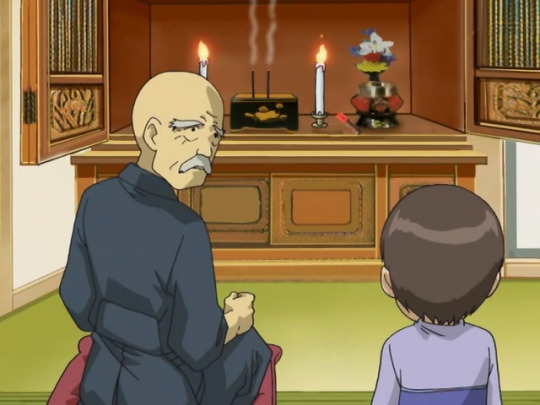

While not in exactly the same way as the Takenouchi family (which is literally working in cultural preservation and study), the Hida family is very traditionalist Japanese -- Fumiko makes traditional Japanese food and snacks like kanpyoumaki and ohagi, and a lot of attention is given to the butsudan altar in their house where they honor the late Hiroki (also note the tatami flooring). That, combined with Chikara’s naturally strict personality, led to Iori being raised with “very strict manners”, and by a set of very firm guidelines on honor, respect, and the like.
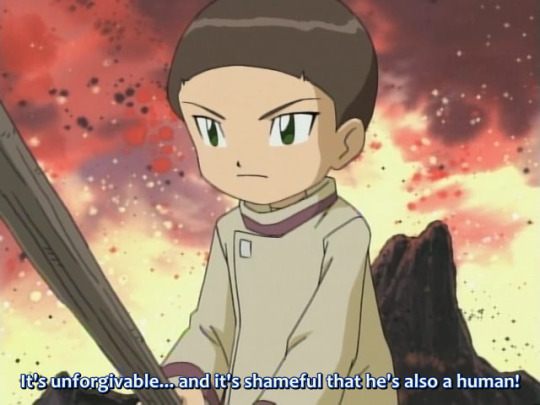
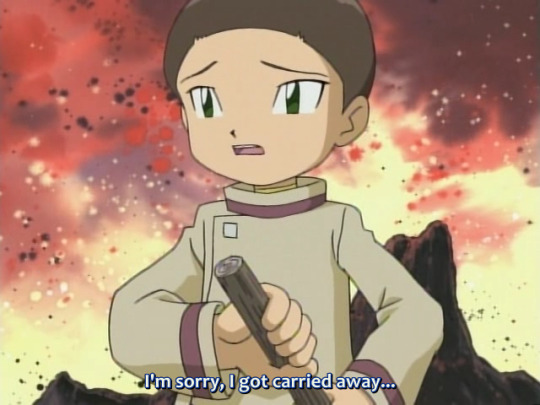
Having been raised into this kind of formality, Iori speaks almost exclusively in polite-form Japanese. This happens to initially make him come off a bit like Koushirou -- likely a deliberate parallel, given the Knowledge connection between the two (being the kind of person who admits that you don’t know everything and wants to know more requires a bit of humility, after all). That said, Iori’s way of doing this has some key differences from Koushirou:
Unlike Koushirou, who was largely polite out of an attempt to keep distance from everyone and thus had a streak of being somewhat non-confrontational, Iori is perfectly willing to say harsh or critical things -- in other words, his way of speaking is formal, but it’s not necessarily polite, and in fact Iori is probably the single most passive-aggressive person in this cast. He has absolutely no qualms about dunking on whatever he feels truly deserves the dunking, and he’ll certainly do it with a lot of grace, but he is very capable of being extremely cold when he wants to be.
Koushirou stuck to formality out of detachment and intimidation, to the point that, as per Adventure episodes 38 and 54, he was compulsively unable to bring himself to speak casually unless he forced himself. Iori, on the other hand, often “slips” -- on top of willingly defaulting to casual form whenever he’s talking to himself or (occasionally) to the Digimon (who are outside Japanese levels of propriety), he also has a tendency to start using casual form whenever he gets particularly emotionally compromised. (While it doesn’t quite come off in the translation, the above screenshots from 02 episode 10 are an example of this, with Iori losing his temper at the Kaiser and slipping into casual form -- and a bit of fun foreshadowing, guess who’s the one to successfully calm him down? Takeru. Remember this for later.) In other words, Iori’s formality is not compulsive, but a conscious thing he tries to maintain as he holds himself to high standards, and is unable to completely uphold during times his emotions get the better of him.
Ultimately, Iori may come off as “mature and composed”, but he’s still an impressionable nine-year-old child, who’s effectively parroting the rules his grandfather instilled in him because he sees it as The One and Only Guide to Living Life. In trying to figure out the right thing to do in any situation, Iori ends up constantly trying to fall back on “this is the right way to do things!” and taking it rather badly whenever things start falling outside of the expected pattern. Despite being the one responsible for Iori’s tightly principled life to begin with, even Chikara himself comments that Iori’s not being flexible enough in his thinking in 02 episode 5 -- because it’s not like he’s expecting Iori to be like this, but Iori is simply having a hard time applying these principles practically when he’s working with the limited range of being a nine-year-old child.

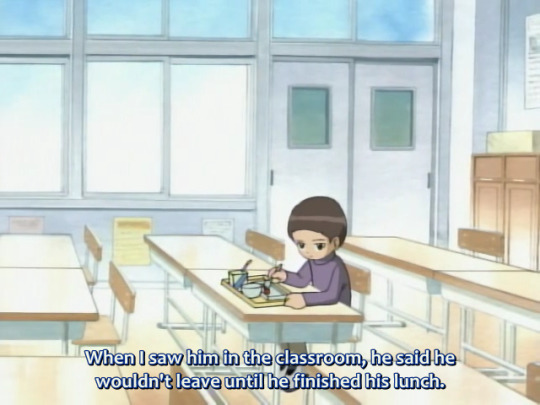
And as much as it may be tempting to see Iori as stoic, watching his expressions and way of emoting throughout the series, he does very much have the full range of emotions and curiosity and even cheer of a nine-year-old child -- it’s that he’s just constantly holding himself back for the sake of being principled and well-mannered. This has the unfortunate side effect that Iori is, as the Animation Chronicle calls it, “clumsy at expressing himself as a child”. Because he’s constantly restraining himself like this, he has a hard time expressing himself or letting himself enjoy things in the way a normal child would.
It also goes a long way in explaining why Iori is never seen hanging out with any other peers his age, and is exclusively depicted in the company of either the rest of the 02 group, or his own family. While part of it is simply because (as per Japanese school procedure) he’s too young to be formally enrolled in any clubs, 02 episode 3 goes out of its way to show Iori being left alone in the classroom with only a teacher stuck supervising him, as he tries to force himself to finish his lunch due to his stubborn adherence to principle (even though he seems to hate tomatoes). In other words, it’s heavily implied that Iori’s own behavior ended up isolating him from his peers. Considering that the 02 group is generally made up of kids who are socially displaced in some way, it naturally follows that, despite being significantly older than him, they end up welcoming him into their friend circle and treating him as an equal.

When the series starts, Miyako and Iori seem to have gotten a certain degree of closeness (with Iori as one of the only people Miyako drops honorifics on). It stands to reason that Miyako, being open-minded towards people and rather aggressively friendly, would be willing to befriend her neighbor despite the three-year age gap between them, and so they already seem to have developed a rapport where Miyako’s willing to come over to his place to help work on the Hida family electronics in exchange for food.

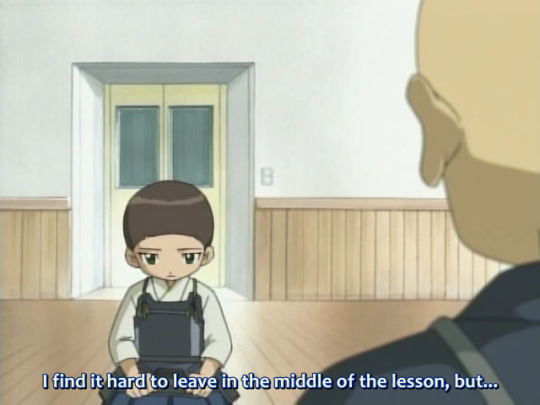
So, you know, this and that happens, Iori becomes a Chosen Child, and this is the start of where Iori’s “principles” start coming into conflict with each other. The nature of the Digital World crisis is a no-brainer -- the Kaiser is doing terrible things, and Iori’s just been given the tools to do something about it, and so for him, upholding his principles to do the right thing means proactively doing something about it. But getting involved in this territory war will mean “fighting and hurting other people” (bad) and “hiding things from his family and sacrificing obligations to them” (also bad). Chikara advises him in 02 episode 5 that he still needs to be the one to decide what he wants and needs to do at any given moment, but it’s clear that this is still a new concept for Iori to swallow.

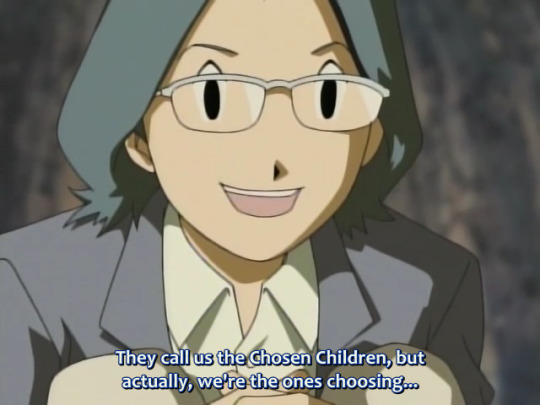
It’s also important that 02 episode 5 is also the episode that introduces Jou, who very much understood the dissonance between “adhering to principles in spite of how practical that may not actually be”, which means the two of them end up bonding over...ditching real-life obligations to come to the Digital World. This bonding happens despite the fact that they have the largest age gap out of any two given kids out of the Adventure and 02 group (Jou is 15, and Iori 9) -- and yet, they’re able to bond over being like-minded like this. And while they come from different contexts, there’s also a parallel drawn between the two on “the importance of personal choice” -- because back in Adventure, Jou’s story involved channeling his desire to help others in a way different from his usual expected path as a doctor or as a Chosen Child, and, likewise, it will be up to Iori to find his own way towards what he thinks is right.


Iori’s “adherence to principles” also needs to be distinguished from Jou’s in that Jou was someone more likely to be stuck to “practical” rules (one might call him Lawful) such as waiting for adults to help them with things, or what to put on eggs. Iori, on the other hand, has self-enforced rules that are far more ideological -- he doesn’t actually care that much about institutionally-enforced rules (note how he has absolutely no issue with sneaking into school with his friends in 02 episode 6) as much as he enforces a moral code on himself about “the right thing to do”. For instance, that he has to show his respect to Jou by formally finishing his introduction, even if it’s clear they know each other by now already.
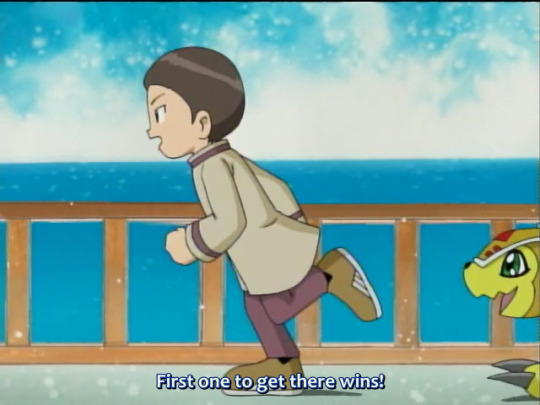



But, again, it bears repeating: Iori is a nine-year-old child. The rest of the kids respect him enough to not treat him like a younger child -- other than a brief moment of emotional compromise that Daisuke quickly apologized for, the group is never really depicted as paying particular mind or care to the fact that Iori is so much younger than them, and for the most part treat him like an equal. But Iori himself is conscious of this -- after all, it’s why he’s constantly speaking politely to everyone all of the time, but 02 episode 16 also implies he’s very self-conscious about this. The plot of the episode kicks off when Iori momentarily gets caught up in his excitement about potentially getting a new Digimental, and, once things start going south, he starts blaming himself for causing all of this and lashing out at the others for (at least, in his mind) singling him out to be the one to escape on the grounds of being the youngest. After all is said and done with the incident, Submarimon lets Iori have a moment of something Iori really does need: a bit of a chance to actually get to enjoy himself as a young child instead of restraining himself so much.

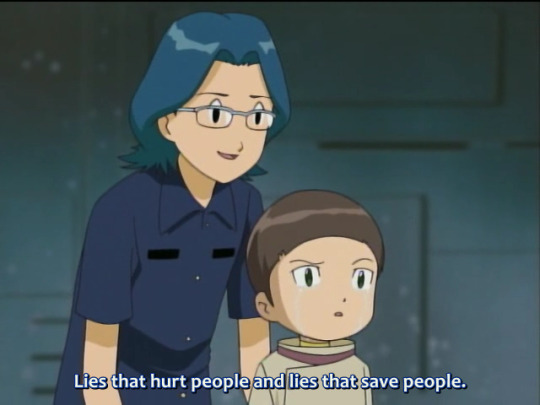
Speaking of 02 episode 16, this is also where we first get to see how the pressure of maintaining Iori’s moral code starts to emotionally tear at him. It’s the first time we see Iori lose his composure this much. To everyone else here (and, perhaps, the audience, to some degree), Iori’s making a mountain out of a molehill -- he’s calling himself an unworthy person for telling a lie that even Jou himself clearly didn’t mind. But remember, Iori is someone who’s still learning a lot about how the world works at such a young age and is inclined by default to fall back on whatever his grandfather’s told him (to a point that even said grandfather considers to be overdoing it). Right now, Iori has basically built his entire view of morality based on this kind of thing, so putting a dent on it is like encouraging a slippery slope of potentially falling into moral depravity.
The reason why I say Iori’s character arc has a lot to do with Adventure and 02’s storytelling itself is that it’s a surprisingly pragmatic series when it comes down to it -- “it’s okay to lie, sometimes” is not exactly the kind of moral you’d expect out of your average kids’ show, but, perhaps a bit unusually, this series prefers to skip all of the preachiness and focus on pragmatics. (After all, back in Adventure, a lot of the final arc revolved around the question of “is fighting the right thing to do when there might be casualties?”, with the probably-kind-of-uncomfortable-but-frankly-very-practical answer of “it certainly beats having more casualties that would happen if you sat around and did nothing.”) Iori’s character arc is, effectively, this in a nutshell -- what’s the “right” thing to do when following principles alone doesn’t seem to be doing it? In the end, both Adventure and 02 are big on this -- preachy words and moralistic principles mean nothing in the face of striving to practically minimize damage and help others.
And so, Jou -- who himself grappled quite a bit with the dissonance between principles and pragmatism back in Adventure -- is the one to successfully reframe it in a way that Iori understands: most of all, Iori doesn’t want to see people get hurt, and whether “lying” or “not lying” is the right thing to do is not as relevant as “whether people are getting hurt”. Iori not lying would have caused a great deal more of hurt than lying, and it’s through understanding this kind of principle that Iori accepts that he still has a long way to go in terms of exercising his duty to others. The secondary Digimental arcs have a heavy theme of “acknowledging your deficiencies and resolving to improve”, and in the case of Iori and the Digimental of (this thing has been translated half a dozen ways, but, effectively, honoring your obligations to others), it involves his first major moment of coming to terms with the idea that the principles on paper he’s been stubbornly following aren’t going to do it by themselves.

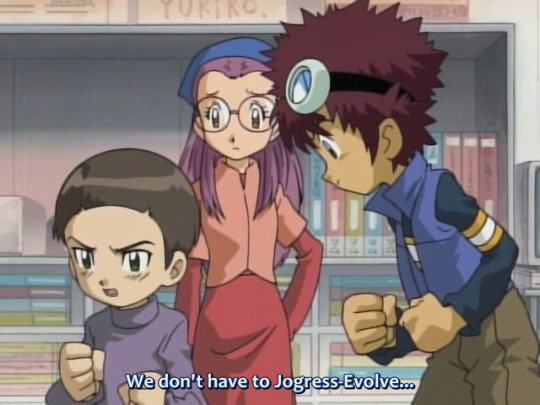
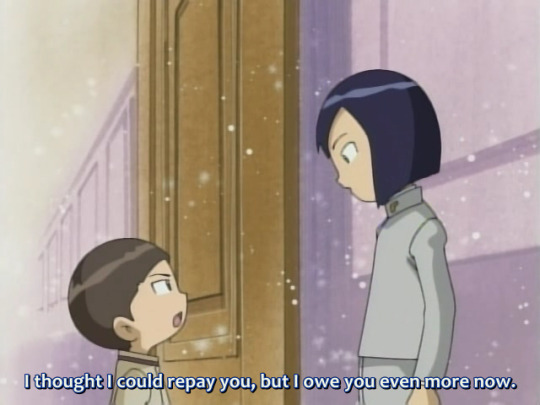
Once the Kaiser arc concludes and the group is posed with the question on how to handle Ichijouji Ken, Iori’s reaction to him is the most infamously extreme: Ken is a Bad Person who is completely beyond forgiveness, and Iori wants nothing to do with him. It probably needs to be made clear that Iori’s stance on not wanting to forgive Ken is not inherently unreasonable. Ken really did some awful, horrible things in the first half of the series, and it is completely within Iori’s rights to decide that he doesn’t want to forgive or like Ken thereafter.
The part where Iori’s behavior starts posing issues is not the part about whether he likes Ken or not, but rather that Iori gets so hung up on that lack of forgiveness that he becomes very bad at observing the practical reality in front of him. Or, in other words, Iori gets so fixated on the principle of what happened in the past that he’s unable to make good judgment calls on what should happen going forward. It is abundantly clear to everyone by (at the latest) 02 episode 26 that Ken is not going to easily lapse back into his old ways and would like to make an effort to repair the damage he caused; regardless of whether they like him or not, it’s in their best interest to cooperate with him and let him help out (and even keep an eye on him to make sure bad things don’t happen again!), especially when the factor of Jogress comes into play and turns out to be a very valuable asset in the fight ahead. But Iori has a a rather squeamish, petty response when he tries to claim that they shouldn’t need Jogress (in the midst of everyone else being excited about the possibilities it poses, even without Ken in the equation) in 02 episode 28, and even when he does go along with everyone working with Ken in 02 episodes 28-29 during the Giga House Incident, he approaches it like he and Ken are bartering favors and that he’ll have to “repay” Ken before he can properly return to pigeonholing Ken as an Unequivocally Bad Person.

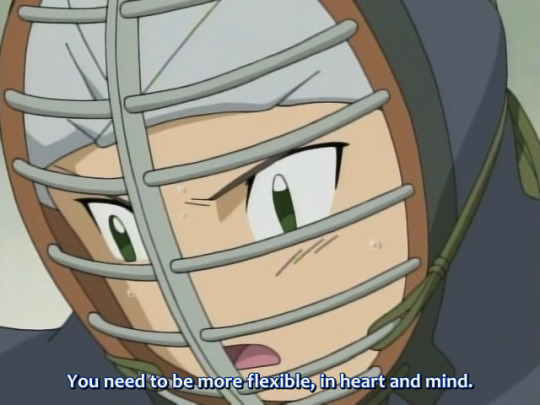
And so the issue here is: Iori being so determined to fixate on trying to stuff Ken into a neat box of a Bad Person isn’t good for himself, either, because it basically means he’s going out of his way to run pointless mental loops and maintain the feeling of stewing in a grudge against him, even when it’s helping absolutely nobody. Note the metaphor drawn when Iori practices kendo with Chikara in 02 episode 24 -- he keeps doing the same motion over and over again despite the fact it’s clearly not going anywhere, and Chikara has to warn him that doing nothing but aim for the head isn’t how you’re supposed to do it. Right now, Iori is having a hard time parsing things in ways besides shoving things in neat boxes of black-and-white morality, and this lack of flexibility is severely restricting his ability to be productive.



What starts to really cause Iori to make a major shift in his thinking process is none other than his connection with Takeru, a subplot that had already started kicking off all the way back in 02 episode 19, when Iori witnesses Takeru suddenly taking a violent shift in mood against the Kaiser to the point it scares him. Iori, of course, considers Takeru to be a “good" and “kind person”, but someone like that should (in his mind) logically not be making sudden, violent outbursts like that -- and especially once he starts advocating for BlackWarGreymon to potentially be killed if it comes down to it, going very against Iori’s fundamental principle that killing anything that’s sentient is unforgivably immoral.
This “contradiction” is what leads Iori to realize that he needs to do much more if he wants to understand Takeru properly, and it’s also the start of how Iori grows into the trait of his first Digimental, “Knowledge” -- or, more specifically (as defined by Koushirou in Adventure episode 24 and 02 episode 2), “curiosity and a drive to know more”. In the case of Iori, this manifests in “I want to know more about other people.” It’s Iori effectively understanding that his very limited view of the world and how people work isn’t sufficient in itself, and this concept becomes the crux of his character arc for the rest of the series.
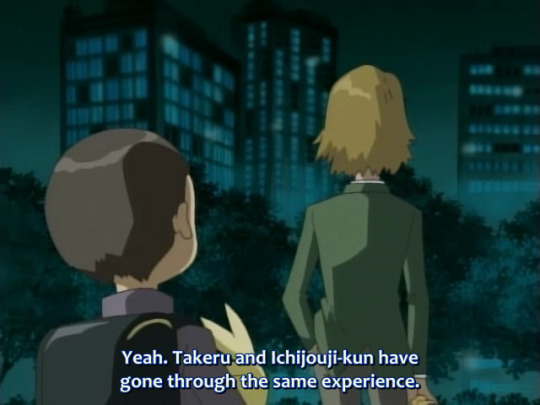
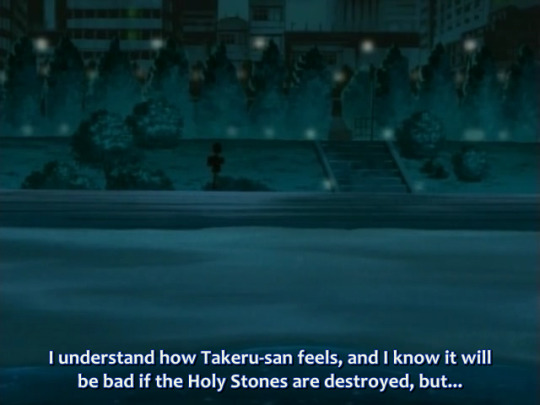
After tussling around and getting increasingly confused about Takeru’s seemingly paradoxical behavior, Iori finally goes directly to Yamato to consult him about it in 02 episode 35, and Yamato explains the backstory behind Takeru’s trauma from losing Angemon back in Adventure episode 13, as well as a reminder that as much as it may have been his own fault, Ken technically went through some pretty similar trauma, and everything that’s happened since his fall from being the Kaiser hasn’t exactly been sunshine and roses for him either. Iori reflects on this as he goes home, with the important statement attached: he understands Takeru’s feelings. He’s now able to understand why Takeru acts the way he does, not on the grounds of principles of what’s right or wrong, but based on the fact that Takeru’s simply a very messy human being who’s not handling his own tendency to suppress his emotions well.
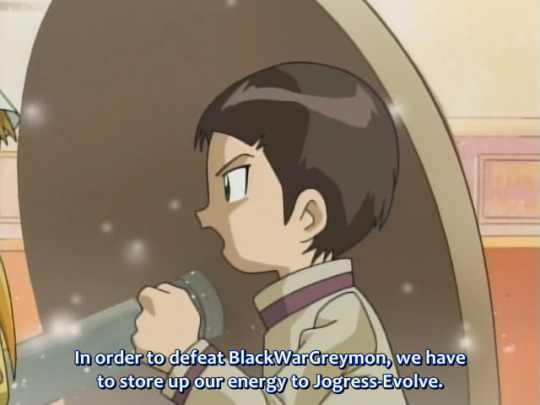


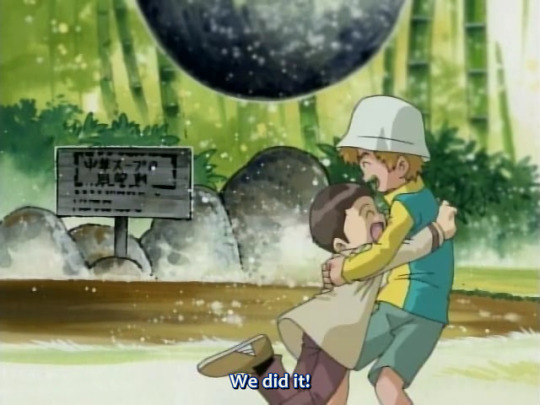
Because Takeru is such a convoluted person, and because Iori’s fundamental issue with approaching things involves unraveling some very deep-seated tendencies in his mentality, the way the two finally connect in order to properly Jogress requires something a lot more convoluted than just happening to clash in a single magical moment like Daisuke and Ken or Miyako and Hikari did. Iori starts off the episode catching himself when he’s about to fall back into “principles over practicality” again -- he starts railing on the others for (in his mind) taking the impending BlackWarGreymon fight too lightly, before Armadimon reminds him that he’s hungry, and Iori realizes -- again -- that he cannot effectively enforce “the right or wrong thing to do” without taking other people’s feelings properly into account. Realizing that this is is a barrier between him and the others, especially Takeru, Iori tries to adjust his thinking pattern and even becomes the one to advocate that everyone get some proper food and rest instead of charging into the fight unprepared.
The meal results in Iori getting yet another rare moment of letting himself truly enjoy something without restraint, and is also followed by Takeru speaking openly to him about their potential Jogress -- openly, honestly, not covering it up, not even with the same light playfulness he would usually put on (including what he had with the very same topic at the beginning of this episode). It is an acknowledgment from Takeru’s own part that he’s been watching what Iori’s doing and also wants to connect, and an open and serious statement from someone who had constantly tried to cover up everything with a smile up until that point, and, with the two reaching an understanding, they finally achieve their Jogress at the end of the episode.
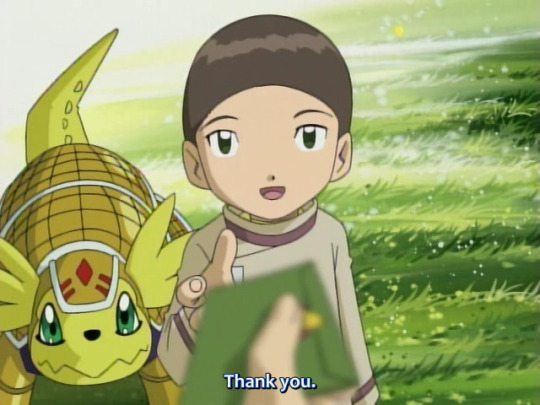
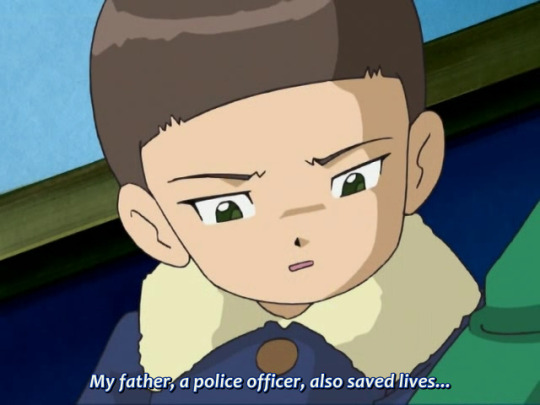
This connection with Takeru, and the understanding that came from it, is what allows Iori to start applying a bit more flexibility towards approaching other situations. 02 episode 38 has him finally accepting Ken’s invitation to his Christmas party, after so many episodes of despising so thoroughly -- because now that he’s taking Ken’s position and feelings into account, he’s able to properly recognize him as someone doing his best to make amends going forward and be friends. Later, in 02 episode 44, despite having originally been the one more staunchly against it on principle, Iori handles the shock of having to kill an enemy with somewhat more grace than Miyako does, because not only had he already started considering the difficulty of fighting an enemy that cannot be reasoned with and wants nothing but wanton destruction (back during the end of 02 episode 29), Takeru is there to remind him that their priority must, first and foremost, be “saving lives” -- like, for instance, the girl in a wheelchair in front of him.

And so, the final episodes of 02 put everything Iori’s learned to the ultimate test, when he learns that the major perpetrator behind it all is none other than a friend of his departed father.
Up until this point, much of Iori’s mentality had been shaped by the rather saintlike image everyone had put up of Hiroki -- it’s almost certain that he must have had his own flaws as a person, but the resistance to speaking ill of the dead, and the generally positive influence he’d had on his friends and family and his untimely death by “protecting someone”, painted him as effectively a perfect, impossible ideal for Iori to strive to. Much of Iori’s justifications for his own behavior had consistently been reliant on “my father said this” or “would my father would have done this?”, such as his reason for forcing down his lunch in 02 episode 3, or using him as a mental model in 02 episode 44. For Iori’s former mentality of “good person” and “bad person”, this is the ultimate contradiction that threatens to rip apart everything Iori had built his own values system on -- that someone so incredible and saintlike and virtuous would be friends with someone so unambiguously doing horrible things like Oikawa. Iori, taking this as an awful emotional blow, parses this with a desperate desire to understand the motive behind why someone would do this, because it’s not enough for him to continue until he does.
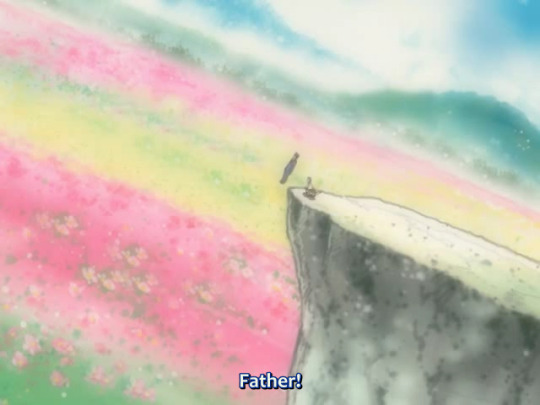
And in 02 episode 49, we see Iori effectively forced to confront the fact that he can’t keep relying on the model of his father anymore as the sole basis for his way of life when, in the end, his father will never return. Iori doesn’t even know him that well; he can’t conjure up an image of him talking, or anything beyond just a flat, serene smile. And when the image of his father finally disappears, Iori almost immediately accepts it, as if he’d known the whole time.
It’s also significant that Iori declares that what he’ll do next is introduce Armadimon to his mother -- because, in the end, Iori is at least now capable of “moving forward”. He can’t get his father back, and the best thing he can do is make use of his existing support group and keep pushing forward with the people he does have in his life -- quite the opposite of Oikawa, who responded to the loss of that exact same person by clutching onto the remnants of the past they shared, and never becoming able to move on.

Hence, 02′s finale ends on none other than Iori, and when you think about it, this is actually a pretty unusual position to be in for someone who’s not the lead protagonist (Daisuke) nor the most prominent focus of the story (Ken)! But it’s a testament to just how important Iori is to this narrative on a thematic level -- all of the struggles about the morality of fighting and the disparity between principles and practicality (which dated all the way back to Adventure), and 02′s prominent theme of coping with loss and regrets and figuring out how to best move on, are all tightly entwined with the character arc of this nine-year-old child. (If you want to take the parallel between the Adventure narrative and Iori even further, Iori and Armadimon sharing the same voice actress is possibly one of the most prominent ways of indicating how a Digimon partner is fundamentally meant to express one’s inner self.)
And especially since Iori is the person who should have been the most vehement about having any kind of sympathy or compassion towards Oikawa -- just remember how determined he was to be cold towards Ken only half a series ago! -- and it leaves a strong impression of the huge, huge journey Iori had gone on through this series. Iori’s arc closes on him understanding the nature of what Oikawa had wanted this whole time, and understanding exactly what it meant for him to make that sacrifice right after finally meeting his partner, and ends the story the most emotionally affected by it -- because, after all, that’s the sort of truly kind person Iori is.
Iori after 02
By the time of Spring 2003, when Iori’s had some time to reflect on it, we learn from Iori that he still does not forgive Oikawa. That in itself is fine; remember, Iori is perfectly within his rights to not do so after all that he’s done. However, again, a distinction must be drawn between whether Iori forgives him, and whether he still considers it to be important to understand the mentality behind why Oikawa did what he did, and to reflect meaningfully on that instead of running himself in circles fixating on a grudge. Again, it’s about going forward with what he knows and has, instead of getting fixated on past deeds -- and with that, Iori resolves to “study”.
In The Door to Summer, we also learn that Iori allegedly has a “girlfriend” -- or, at least, someone Daisuke calls his girlfriend (Daisuke is a bit of an unreliable narrator here, given he’s also totally blown Hikari’s “rejection” of his beach hangout offer up as if it were a full-on total rejection of him completely). It is, perhaps, interesting that Daisuke is capable of getting this impression about Iori’s relationship with someone outside the 02 group, given that he’d been rather isolated from his peers all the way back in 02 episode 3...
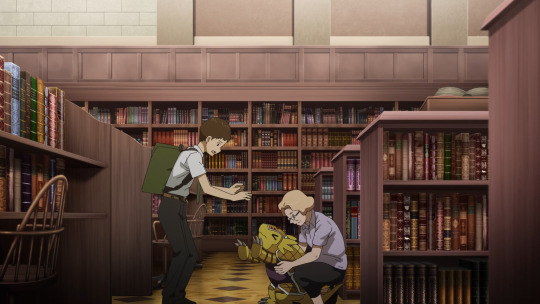


Iori occupies an interesting position in Kizuna, because we only have one point in time where we got to intimately know him, and that was back when he was only nine years old -- and between that and Kizuna, there is a massive eight-year timeskip. He's 17 now, and we don't get any kind of catch-up period in the middle like we did with Takeru and Hikari in 02, and that is a time period where a lot of changes in demeanor could have happened with him compared to all of the others.
At first glance, it seems that he’s gotten much more stoic -- but this is actually something that should reasonably be expected, because now that he’s a teenager, it stands to reason that he would be much better at actually controlling his emotions and not necessarily get overwhelmed as easily. Plus, it’s not like he’s shown to be completely emotionless throughout the movie; he’s just doing a much more graceful job of holding himself back (look carefully at the credits and you can see him sweatdropping at Armadimon barging in on his practice), and moreover you can still see him deliver some pretty direct bluntness about the ramen in New York. Still with formal language, but nevertheless, no flattery is to be had here; Iori will dunk on you if he thinks you deserve it (even if it’s to do with mediocre ramen).
But there are some other interesting observations -- for one, the official website profile states that he’s actually settled on his future career in law at this point, and has made himself extremely busy in order to do so. (On top of that, he at least seems to be on friendly enough terms with his peers at school that they’re happy to greet him on their way out.) The drama CD indicates that Daisuke considers him the busiest out of the entire 02 group -- yet he and Takeru went out of their way to pick him up from school, because he’s that important to them. (Think about it -- how often do you see university students going this far to go retrieve a high school kid to hang out with them?) And likewise, Iori doesn’t even hesitate to state that he’ll make time for them, and throughout the movie he’s conspicuously seen in his school uniform, implying he really is moving things around to make it happen, because they’re that important to him.
He also engages in the single most chaotic action from this group, which is getting Armadimon to break into Menoa’s lab. It’s not that he’d inherently been against this kind of thing before, especially for something important (recall that he’d been happy to sneak into school for Golden Week with the others back during 02 episode 6), but it does beg the question of where and how he got this information that Armadimon could break electric locks. Perhaps he’s become a bit more, ah, pragmatic of a person since 02...
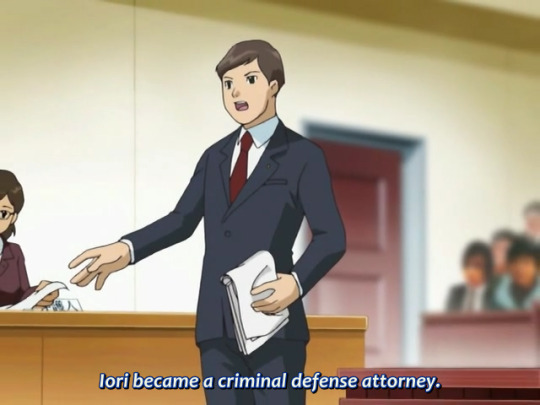
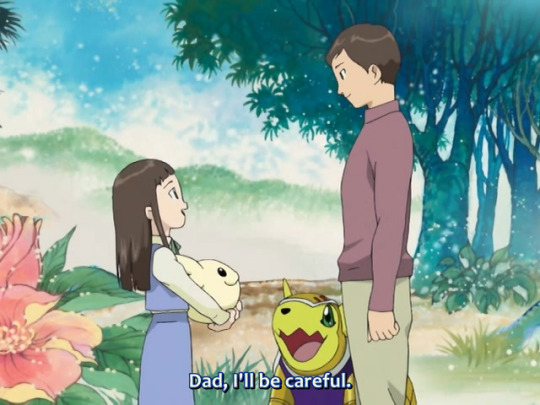
So, in the end, Iori does become an attorney, and specifically a defense attorney (the Japanese law system does draw the distinction). The person who once wanted to stick people he considered to be doing wrong into a “bad people” box and call it a day eventually came to embrace a career that involves understanding people and advocating for their perspective, or at least bargaining for something other than defaulting to the harshest assumption and a solution that allows all of the parties to best productively move forward.
He also has a daughter, who seems to have been raised to be as well-mannered and formal as he was. But, thankfully, he himself is there to help raise and guide her as she grows up.
#digimon#digimon adventure 02#digimon adventure last evolution kizuna#kizuna spoilers#hida iori#iori hida#shihameta
102 notes
·
View notes